Impact of Waste Fry Biofuel on Diesel Engine Performance and Emissions
Abstract
1. Introduction
2. Biodiesel Manufacturing and Characteristics
3. Experimental Setup
4. Results and Discussion
4.1. Effect on the Brake Thermal Efficiency
4.2. Effect on the BSFC (Brake-Specific Fuel Consumption)
4.3. Effect on CO2 Emissions with Engine Rpm
4.4. Variation of NOx Emissions with Engine Rpm
4.5. Variation in CO Emissions
4.6. Variation in HC Emissions
4.7. Variation in the Smoke Opacity with Engine Rpm
4.8. Variation of the Exhaust Temperature with Engine Rpm
5. Conclusions
Author Contributions
Funding
Data Availability Statement
Conflicts of Interest
Nomenclature
| BSFC | Brake-specific fuel consumption |
| BTE | Brake thermal efficiency |
| CI | Compression ignition |
| CO | Carbon monoxide |
| FWCOB | Fry waste cooking oil biodiesel |
| HC | Hydrocarbon |
| HRR | Heat release rate |
| IC | Internal combustion |
| NOx | Nitrogen oxide |
| WCO | Waste cooking oil |
References
- Montgomery, H. Preventing the Progression of Climate Change: One Drug or Polypill? Biofuel Res. J. 2017, 4, 536. [Google Scholar] [CrossRef]
- Thiyagarajan, S.; Edwin Geo, V.; Martin, L.J.; Nagalingam, B. Comparative Analysis of Various Methods to Reduce CO2 Emission in a Biodiesel Fueled CI Engine. Fuel 2019, 253, 146–158. [Google Scholar] [CrossRef]
- Feng, R.; Hu, X.; Li, G.; Sun, Z.; Deng, B. A Comparative Investigation between Particle Oxidation Catalyst (POC) and Diesel Particulate Filter (DPF) Coupling Aftertreatment System on Emission Reduction of a Non-Road Diesel Engine. Ecotoxicol. Environ. Saf. 2022, 238, 113576. [Google Scholar] [CrossRef]
- Simsek, S. Effects of Biodiesel Obtained from Canola, Sefflower Oils and Waste Oils on the Engine Performance and Exhaust Emissions. Fuel 2020, 265, 117026. [Google Scholar] [CrossRef]
- Yontar, A.A.; Doğu, Y. Investigation of the Effects of Gasoline and CNG Fuels on a Dual Sequential Ignition Engine at Low and High Load Conditions. Fuel 2018, 232, 114–123. [Google Scholar] [CrossRef]
- Musthafa, M.M. A Comparative Study on Coated and Uncoated Diesel Engine Performance and Emissions Running on Dual Fuel (LPG—Biodiesel) with and without Additive. Ind. Crops Prod. 2019, 128, 194–198. [Google Scholar] [CrossRef]
- Juknelevicius, R.; Szwaja, S.; Pyrc, M.; Gruca, M. Influence of Hydrogen Co-Combustion with Diesel Fuel on Performance, Smoke and Combustion Phases in the Compression Ignition Engine. Int. J. Hydrogen Energy 2019, 44, 19026–19034. [Google Scholar] [CrossRef]
- Emiroğlu, A.O.; Şen, M. Combustion, Performance and Emission Characteristics of Various Alcohol Blends in a Single Cylinder Diesel Engine. Fuel 2018, 212, 34–40. [Google Scholar] [CrossRef]
- Sidibe, S.; Blin, J.; Daho, T.; Vaitilingom, G.; Koulidiati, J. Comparative Study of Three Ways of Using Jatropha Curcas Vegetable Oil in a Direct Injection Diesel Engine. Sci. Afr. 2020, 7, e00290. [Google Scholar] [CrossRef]
- Rakopoulos, D.C. Heat Release Analysis of Combustion in Heavy-Duty Turbocharged Diesel Engine Operating on Blends of Diesel Fuel with Cottonseed or Sunflower Oils and Their Bio-Diesel. Fuel 2012, 96, 524–534. [Google Scholar] [CrossRef]
- Feng, R.; Li, G.; Sun, Z.; Hu, X.; Deng, B.; Fu, J. Potential of Emission Reduction of a Turbo-Charged Non-Road Diesel Engine without Aftertreatment under Multiple Operating Scenarios. Energy 2023, 263, 125832. [Google Scholar] [CrossRef]
- Feng, R.; Hu, X.; Li, G.; Sun, Z.; Ye, M.; Deng, B. Exploration on the Emissions and Catalytic Reactors Interactions of a Non-Road Diesel Engine through Experiment and System Level Simulation. Fuel 2023, 342, 127746. [Google Scholar] [CrossRef]
- Aydin, H. Combined Effects of Thermal Barrier Coating and Blending with Diesel Fuel on Usability of Vegetable Oils in Diesel Engines. Appl. Therm. Eng. 2013, 51, 623–629. [Google Scholar] [CrossRef]
- Lapuerta, M.; Armas, O.; Herreros, J.M. Emissions from a Diesel–Bioethanol Blend in an Automotive Diesel Engine. Fuel 2008, 87, 25–31. [Google Scholar] [CrossRef]
- Canakci, M. Combustion Characteristics of a Turbocharged DI Compression Ignition Engine Fueled with Petroleum Diesel Fuels and Biodiesel. Bioresour. Technol. 2007, 98, 1167–1175. [Google Scholar] [CrossRef]
- Qi, D.H.; Chen, H.; Geng, L.M.; Bian, Y.Z. Effect of Diethyl Ether and Ethanol Additives on the Combustion and Emission Characteristics of Biodiesel-Diesel Blended Fuel Engine. Renew. Energy 2011, 36, 1252–1258. [Google Scholar] [CrossRef]
- Oni, B.A.; Oluwatosin, D. Emission Characteristics and Performance of Neem Seed (Azadirachta Indica) and Camelina (Camelina Sativa) Based Biodiesel in Diesel Engine. Renew. Energy 2020, 149, 725–734. [Google Scholar] [CrossRef]
- Lapuerta, M.; Armas, O.; Rodriguez-Fernandez, J. Effect of Biodiesel Fuels on Diesel Engine Emissions. Prog. Energy Combust. Sci. 2008, 34, 198–223. [Google Scholar] [CrossRef]
- Aydin, H.; İlkılıç, C. Effect of Ethanol Blending with Biodiesel on Engine Performance and Exhaust Emissions in a CI Engine. Appl. Therm. Eng. 2010, 30, 1199–1204. [Google Scholar] [CrossRef]
- Graboski, M.S.; McCormick, R.L. Combustion of Fat and Vegetable Oil Derived Fuels in Diesel Engines. Prog. Energy Combust. Sci. 1998, 24, 125–164. [Google Scholar] [CrossRef]
- Mandal, A.; Cho, H.; Chauhan, B.S. Experimental Investigation of Multiple Fry Waste Soya Bean Oil in an Agricultural CI Engine. Energies 2022, 15, 3209. [Google Scholar] [CrossRef]
- Chauhan, B.S.; Kumar, N.; Du Jun, Y.; Lee, K.B. Performance and Emission Study of Preheated Jatropha Oil on Medium Capacity Diesel Engine. Energy 2010, 35, 2484–2492. [Google Scholar] [CrossRef]
- Kulkarni, M.G.; Dalai, A.K. Waste Cooking Oil an Economical Source for Biodiesel: A Review. Ind. Eng. Chem. Res. 2006, 45, 2901–2913. [Google Scholar] [CrossRef]
- Can, Ö. Combustion Characteristics, Performance and Exhaust Emissions of a Diesel Engine Fueled with a Waste Cooking Oil Biodiesel Mixture. Energy Convers. Manag. 2014, 87, 676–686. [Google Scholar] [CrossRef]
- Gui, M.M.; Lee, K.T.; Bhatia, S. Feasibility of Edible Oil vs. Non-Edible Oil vs. Waste Edible Oil as Biodiesel Feedstock. Energy 2008, 33, 1646–1653. [Google Scholar] [CrossRef]
- Canakci, M. The Potential of Restaurant Waste Lipids as Biodiesel Feedstocks. Bioresour. Technol. 2007, 98, 183–190. [Google Scholar] [CrossRef]
- Dorado, M.P.; Ballesteros, E.; de Almeida, J.A.; Schellert, C.; Löhrlein, H.P.; Krause, R. An Alkali-Catalyzed Transesterification Process for High Free Fatty Acid Waste Oils. Trans. ASAE 2002, 45, 525–529. [Google Scholar] [CrossRef]
- Zhang, Y.; Lou, D.; Tan, P.; Hu, Z.; Fang, L. Effects of Waste-Cooking-Oil Biodiesel Blends on Diesel Vehicle Emissions and Their Reducing Characteristics with Exhaust after-Treatment System. J. Clean. Prod. 2022, 381, 135190. [Google Scholar] [CrossRef]
- Akcay, M.; Yilmaz, I.T.; Feyzioglu, A. The Influence of Hydrogen Addition on the Combustion Characteristics of a Common-Rail CI Engine Fueled with Waste Cooking Oil Biodiesel/Diesel Blends. Fuel Process. Technol. 2021, 223, 106999. [Google Scholar] [CrossRef]
- Dharmalingam, B.; Balamurugan, S.; Wetwatana, U.; Tongnan, V.; Sekhar, C.; Paramasivam, B.; Cheenkachorn, K.; Tawai, A.; Sriariyanun, M. Comparison of Neural Network and Response Surface Methodology Techniques on Optimization of Biodiesel Production from Mixed Waste Cooking Oil Using Heterogeneous Biocatalyst. Fuel 2023, 340, 127503. [Google Scholar] [CrossRef]
- Sharma, V.; Kalam Hossain, A.; Ahmed, A.; Rezk, A. Study on Using Graphene and Graphite Nanoparticles as Fuel Additives in Waste Cooking Oil Biodiesel. Fuel 2022, 328, 125270. [Google Scholar] [CrossRef]
- EL-Seesy, A.I.; Waly, M.S.; El-Batsh, H.M.; El-Zoheiry, R.M. Enhancement of the Waste Cooking Oil Biodiesel Usability in the Diesel Engine by Using N-Decanol, Nitrogen-Doped, and Amino-Functionalized Multi-Walled Carbon Nanotube. Energy Convers. Manag. 2023, 277, 116646. [Google Scholar] [CrossRef]
- Chauhan, B.S.; Kumar, N.; Cho, H.M. A Study on the Performance and Emission of a Diesel Engine Fueled with Jatropha Biodiesel Oil and Its Blends. Energy 2012, 37, 616–622. [Google Scholar] [CrossRef]
- Mahla, S.K.; Safieddin Ardebili, S.M.; Mostafaei, M.; Dhir, A.; Goga, G.; Chauhan, B.S. Multi-Objective Optimization of Performance and Emissions Characteristics of a Variable Compression Ratio Diesel Engine Running with Biogas-Diesel Fuel Using Response Surface Techniques. Energy Sources Part A Recover. Util. Environ. Eff. 2020, 1–18. [Google Scholar] [CrossRef]
- Bhuiya, M.; Rasul, M.; Khan, M.; Ashwath, N. Performance and Emission Characteristics of Binary Mixture of Poppy and Waste Cooking Biodiesel. Energy Procedia 2017, 110, 523–528. [Google Scholar] [CrossRef]
- Verma, P.; Sharma, M.P.; Dwivedi, G. Potential Use of Eucalyptus Biodiesel in Compressed Ignition Engine. Egypt. J. Pet. 2016, 25, 91–95. [Google Scholar] [CrossRef]
- Qi, D.H.; Chen, H.; Geng, L.M.; Bian, Y.Z. Experimental Studies on the Combustion Characteristics and Performance of a Direct Injection Engine Fueled with Biodiesel/Diesel Blends. Energy Convers. Manag. 2010, 51, 2985–2992. [Google Scholar] [CrossRef]
- Singh, A.; Maurya, R.K. Effects of Intake Charge Temperature and Relative Air-Fuel Ratio on the Deterministic Characteristics of Cyclic Combustion Dynamics of a HCCI Engine. Int. J. Engine Res. 2022, 24, 146808742211065. [Google Scholar] [CrossRef]
- Azad, A.K.; Rasul, M.; Khan, M.M.; Sharma, S. Macadamia Biodiesel as a Sustainable and Alternative Transport Fuel in Australia. Energy Procedia 2017, 110, 543–548. [Google Scholar] [CrossRef]
- Imtenan, S.; Masjuki, H.H.; Varman, M.; Kalam, M.A.; Arbab, M.I.; Sajjad, H.; Ashrafur Rahman, S.M. Impact of Oxygenated Additives to Palm and Jatropha Biodiesel Blends in the Context of Performance and Emissions Characteristics of a Light-Duty Diesel Engine. Energy Convers. Manag. 2014, 83, 149–158. [Google Scholar] [CrossRef]
- Mahla, S.K.; Singla, V.; Sandhu, S.S.; Dhir, A. Studies on Biogas-Fuelled Compression Ignition Engine under Dual Fuel Mode. Environ. Sci. Pollut. Res. 2018, 25, 9722–9729. [Google Scholar] [CrossRef] [PubMed]
- Mahla, S.K.; Parmar, K.S.; Singh, J.; Dhir, A.; Sandhu, S.S.; Chauhan, B.S. Trend and Time Series Analysis by ARIMA Model to Predict the Emissions and Performance Characteristics of Biogas Fueled Compression Ignition Engine. Energy Sources Part A Recover. Util. Environ. Eff. 2019, 1–12. [Google Scholar] [CrossRef]
- Mahla, S.K.; Goga, G.; Cho, H.M.; Dhir, A.; Chauhan, B.S. Separate Effect of Biodiesel, n-Butanol, and Biogas on Performance and Emission Characteristics of Diesel Engine: A Review. Biomass Convers. Biorefinery 2023, 13, 447–469. [Google Scholar] [CrossRef]
- Liaquat, A.M.; Masjuki, H.H.; Kalam, M.A.; Fattah, I.M.R.; Hazrat, M.A.; Varman, M.; Mofijur, M.; Shahabuddin, M. Effect of Coconut Biodiesel Blended Fuels on Engine Performance and Emission Characteristics. Procedia Eng. 2013, 56, 583–590. [Google Scholar] [CrossRef]
- Palash, S.M.; Masjuki, H.H.; Kalam, M.A.; Masum, B.M.; Sanjid, A.; Abedin, M.J. State of the Art of NOx Mitigation Technologies and Their Effect on the Performance and Emission Characteristics of Biodiesel-Fueled Compression Ignition Engines. Energy Convers. Manag. 2013, 76, 400–420. [Google Scholar] [CrossRef]
- Mahalingam, A.; Munuswamy, D.B.; Devarajan, Y.; Radhakrishnan, S. Emission and Performance Analysis on the Effect of Exhaust Gas Recirculation in Alcohol-Biodiesel Aspirated Research Diesel Engine. Environ. Sci. Pollut. Res. 2018, 25, 12641–12647. [Google Scholar] [CrossRef]
- Zhihao, M.; Xiaoyu, Z.; Junfa, D.; Xin, W.; Bin, X.; Jian, W. Study on Emissions of a DI Diesel Engine Fuelled with Pistacia Chinensis Bunge Seed Biodiesel-Diesel Blends. Procedia Environ. Sci. 2011, 11, 1078–1083. [Google Scholar] [CrossRef]
- Abed, K.A.; El Morsi, A.K.; Sayed, M.M.; El Shaib, A.A.; Gad, M.S. Effect of Waste Cooking-Oil Biodiesel on Performance and Exhaust Emissions of a Diesel Engine. Egypt. J. Pet. 2018, 27, 985–989. [Google Scholar] [CrossRef]
- Buyukkaya, E. Effects of Biodiesel on a DI Diesel Engine Performance, Emission and Combustion Characteristics. Fuel 2010, 89, 3099–3105. [Google Scholar] [CrossRef]
- Utlu, Z.; Koçak, M.S. The Effect of Biodiesel Fuel Obtained from Waste Frying Oil on Direct Injection Diesel Engine Performance and Exhaust Emissions. Renew. Energy 2008, 33, 1936–1941. [Google Scholar] [CrossRef]
- Altaie, M.A.H.; Janius, R.B.; Rashid, U.; Taufiq-Yap, Y.H.; Yunus, R.; Zakaria, R.; Adam, N.M. Performance and Exhaust Emission Characteristics of Direct-Injection Diesel Engine Fueled with Enriched Biodiesel. Energy Convers. Manag. 2015, 106, 365–372. [Google Scholar] [CrossRef]
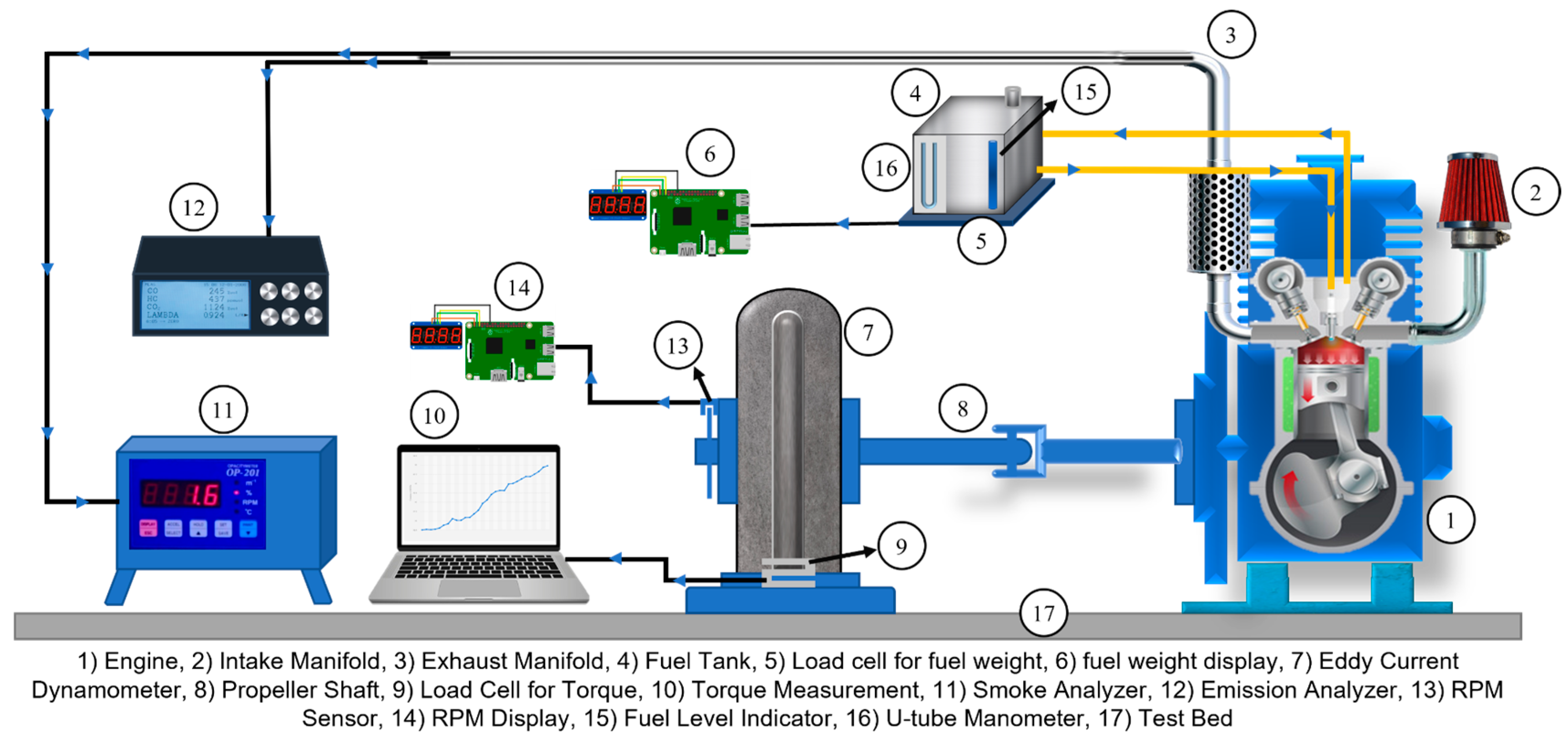
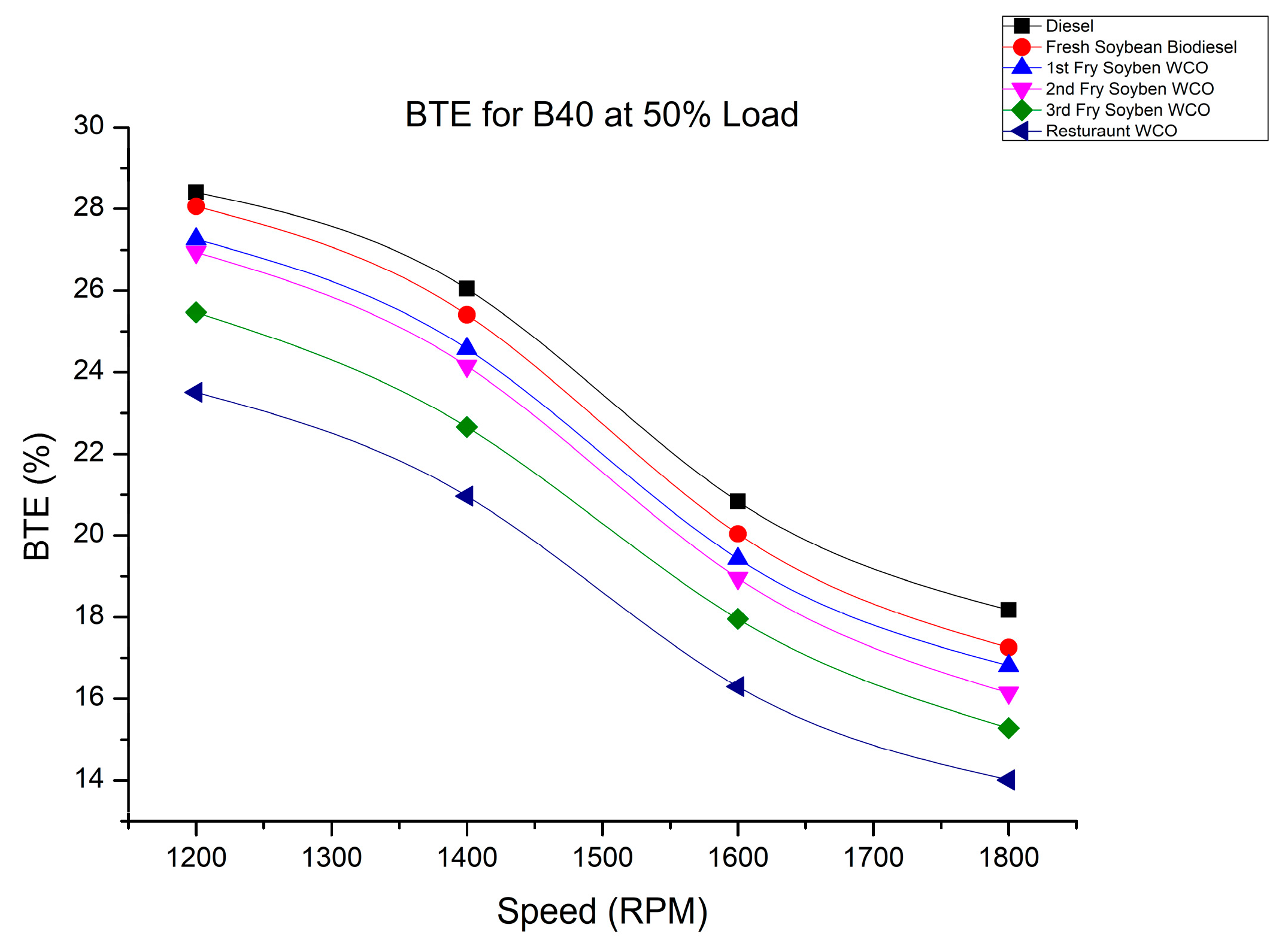
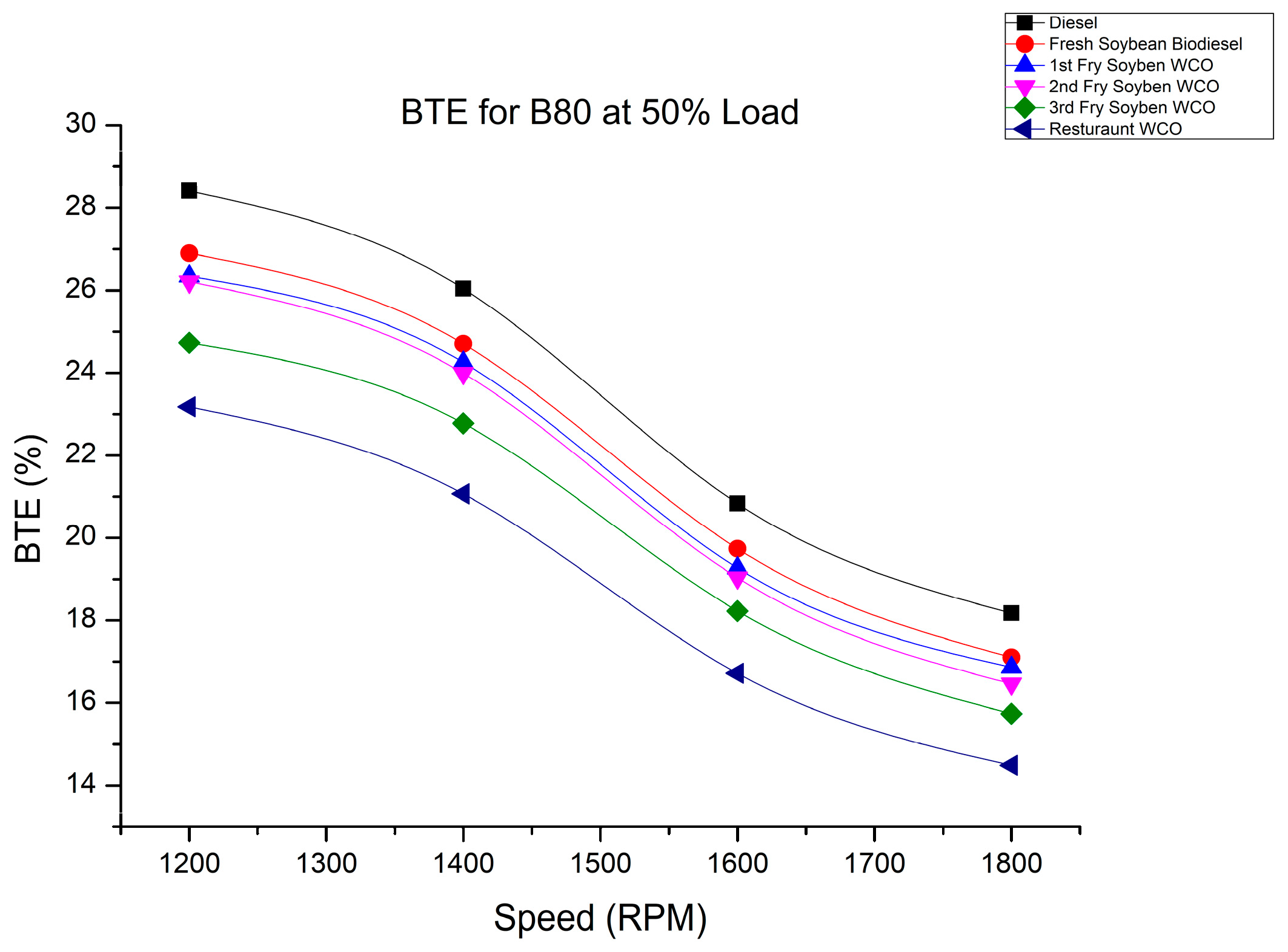
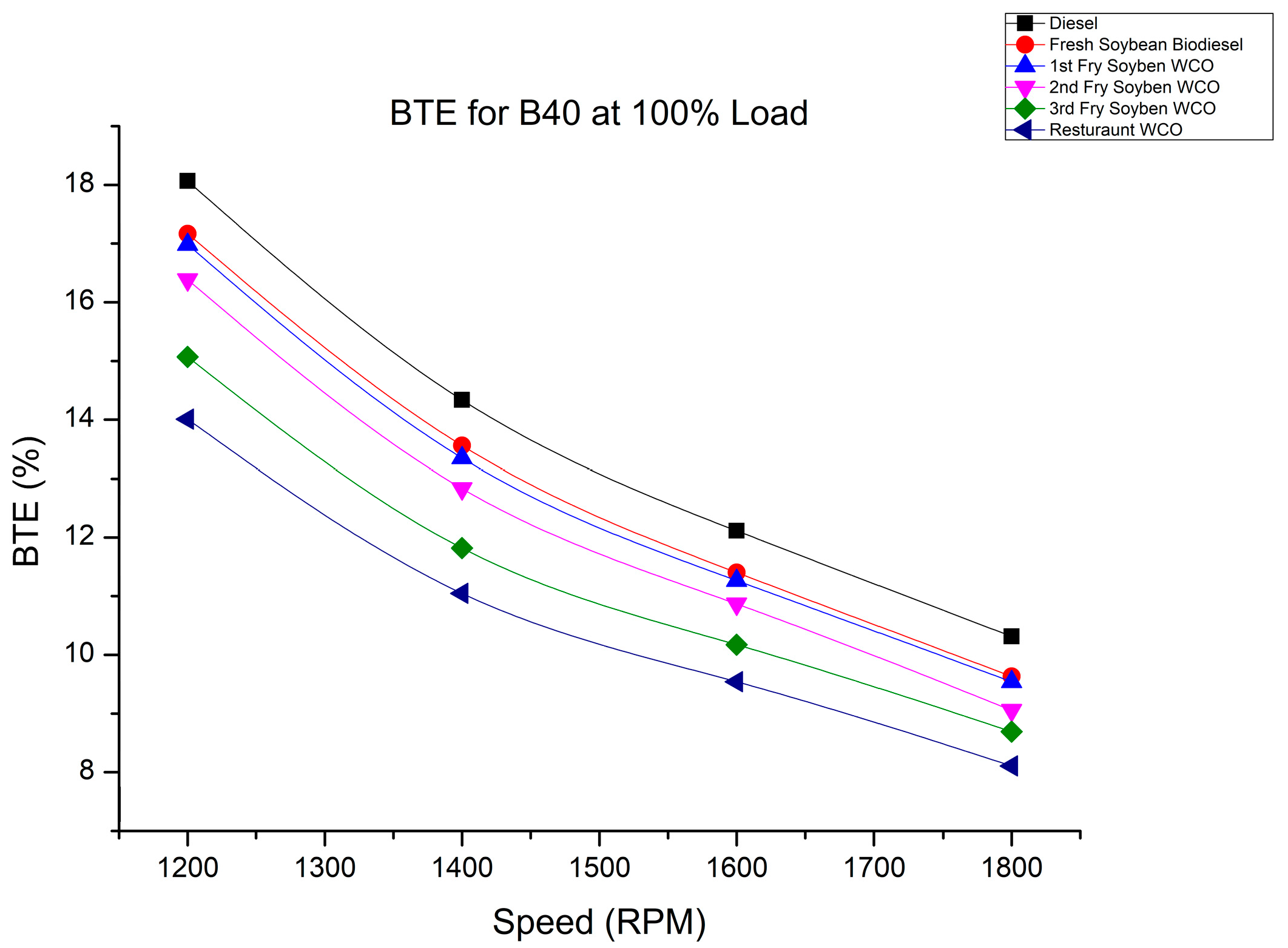

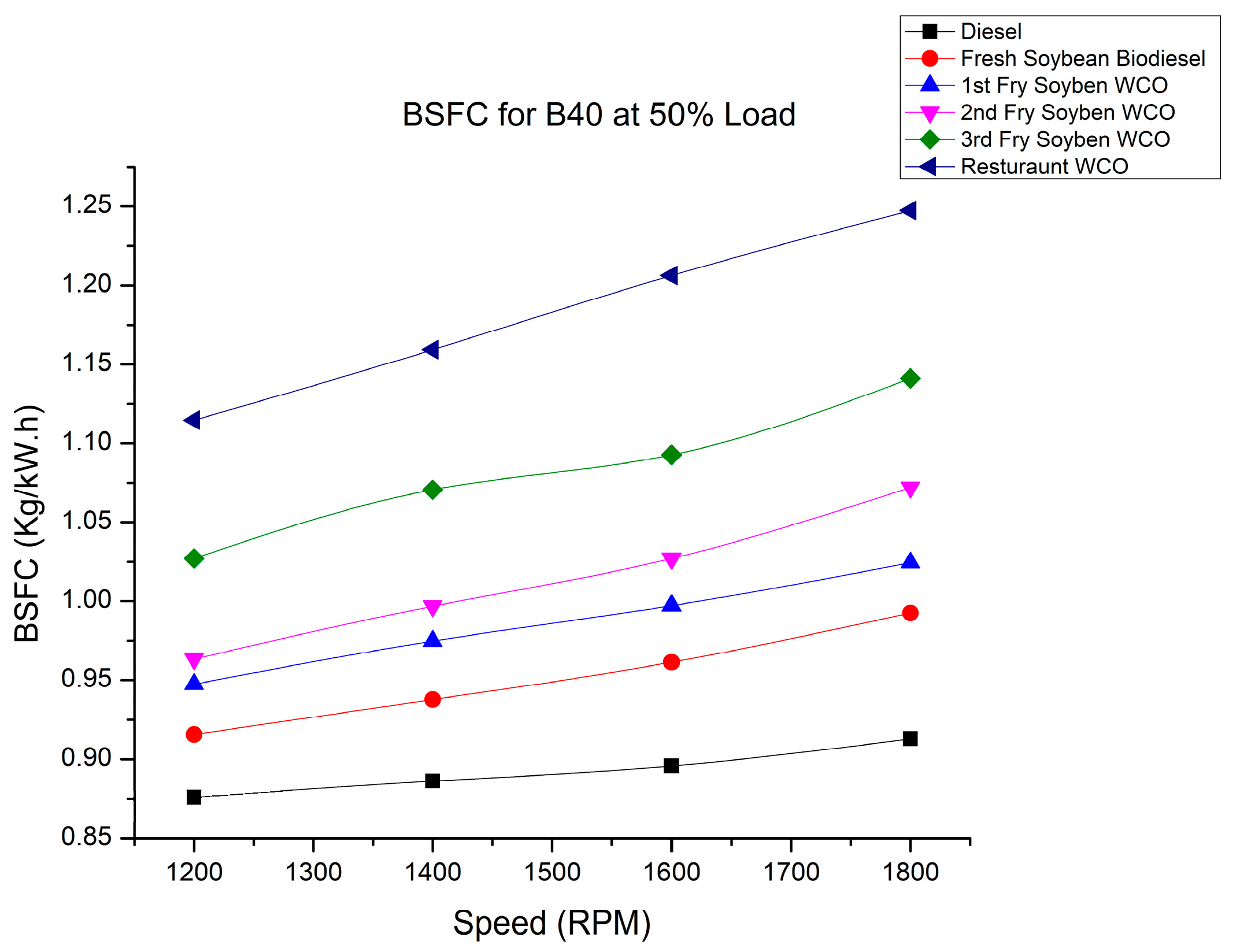


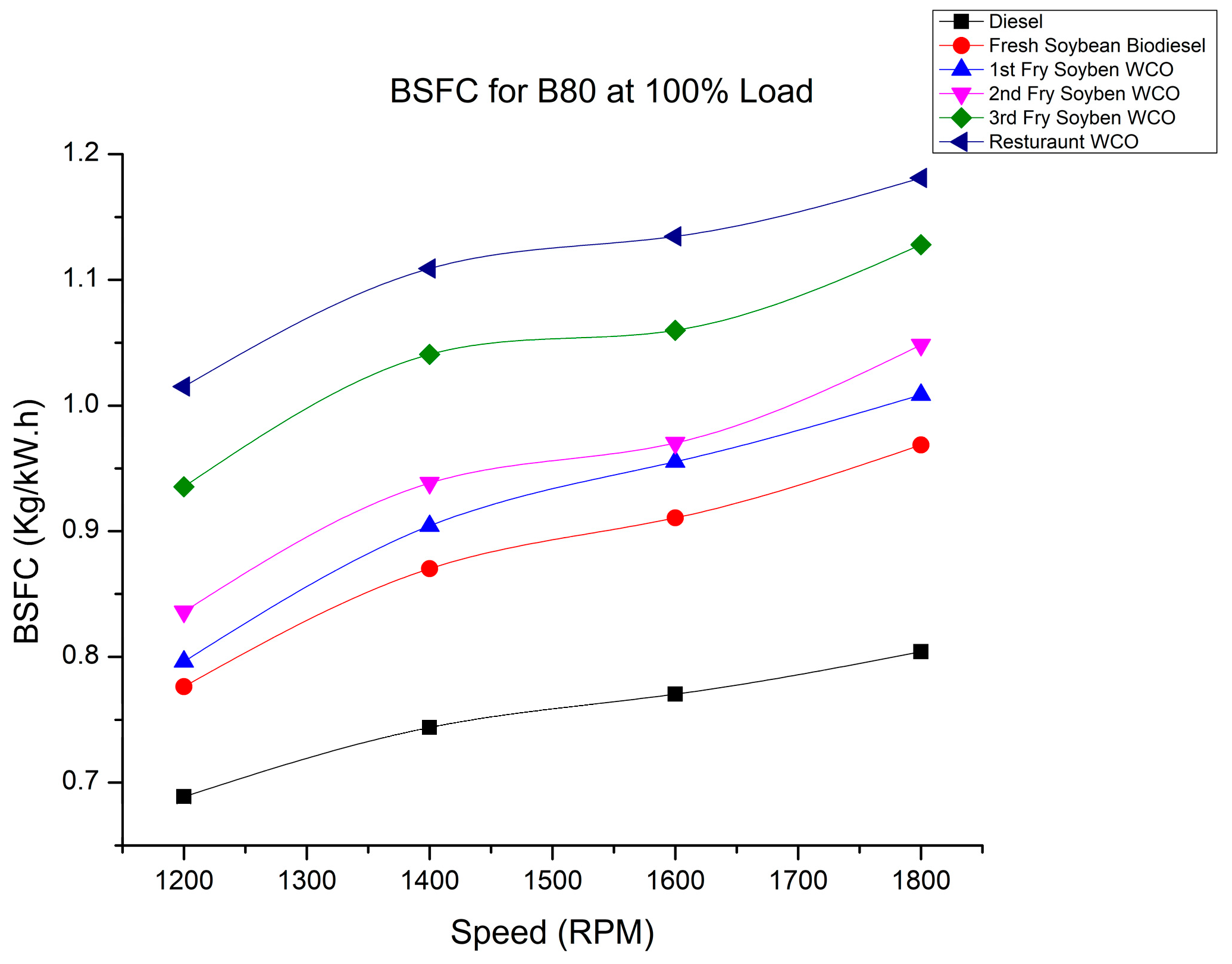

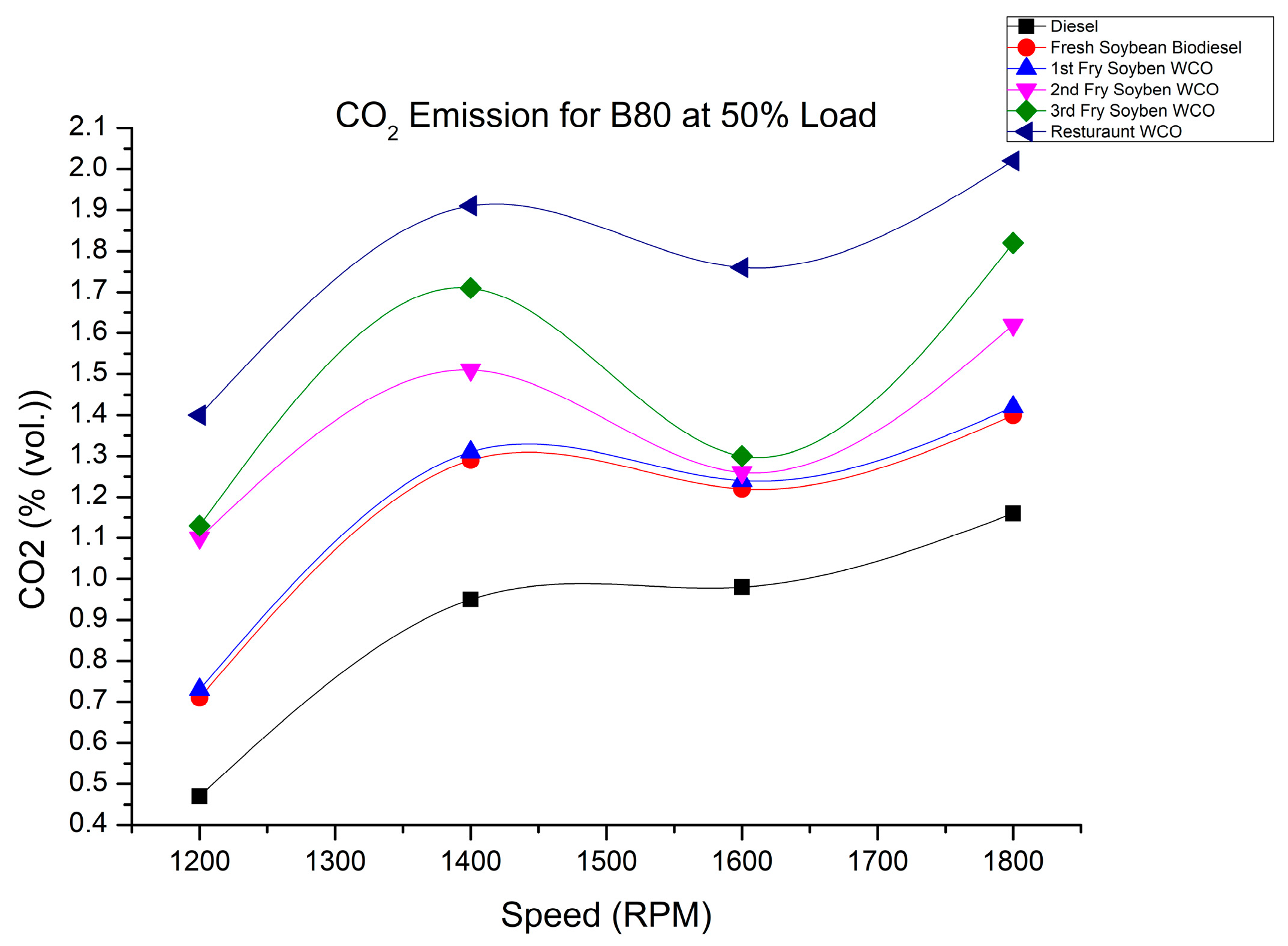
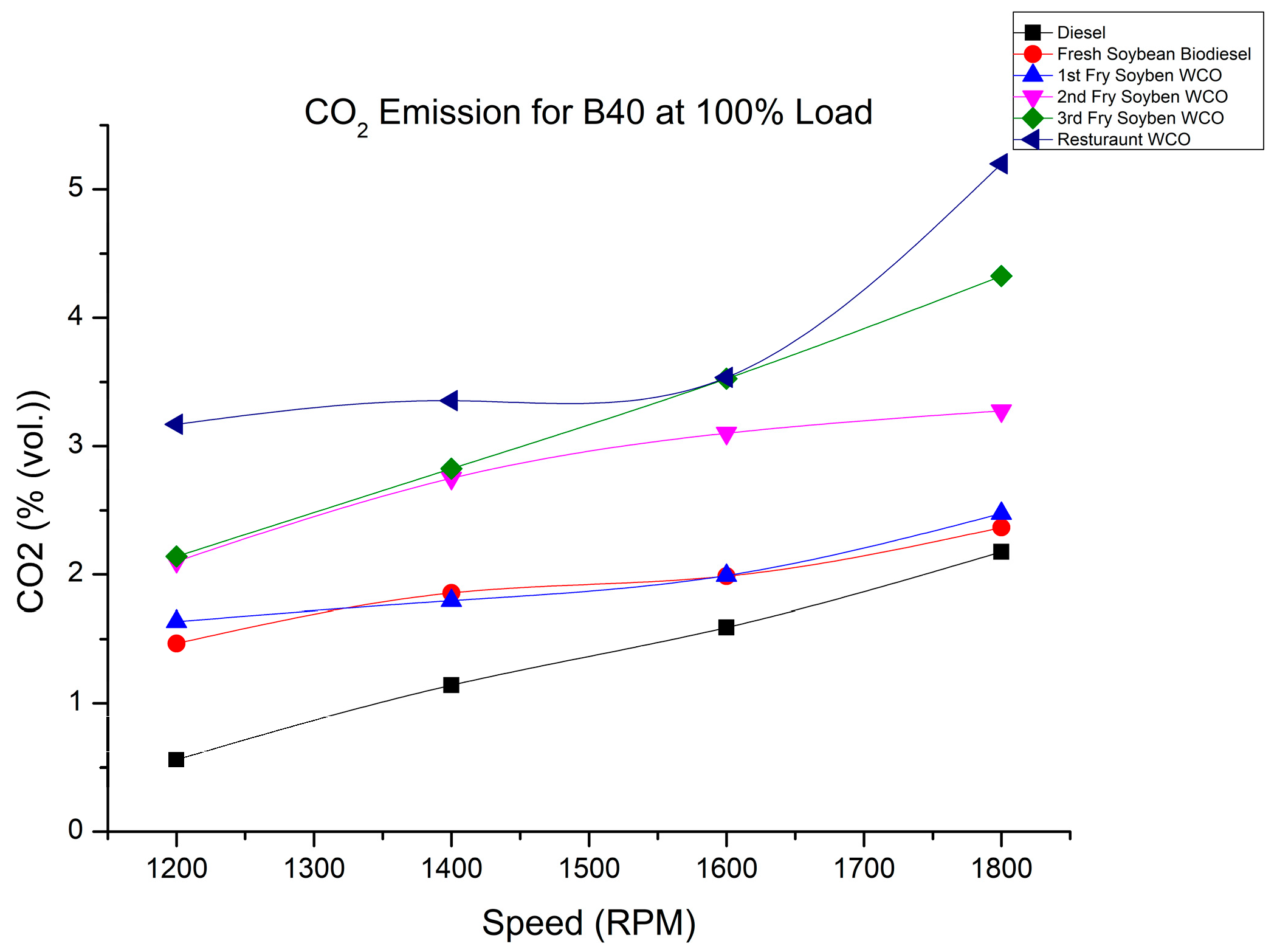


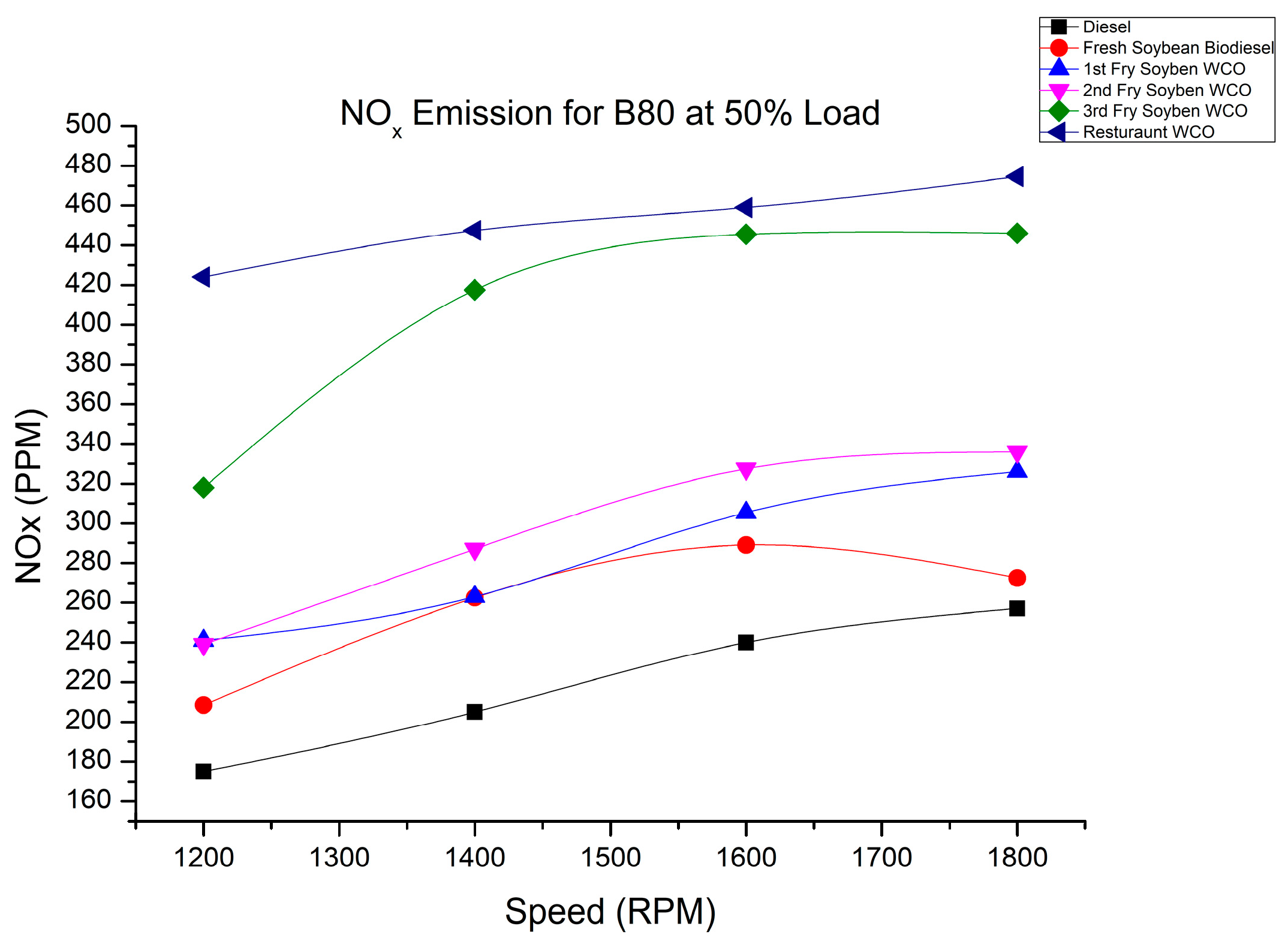
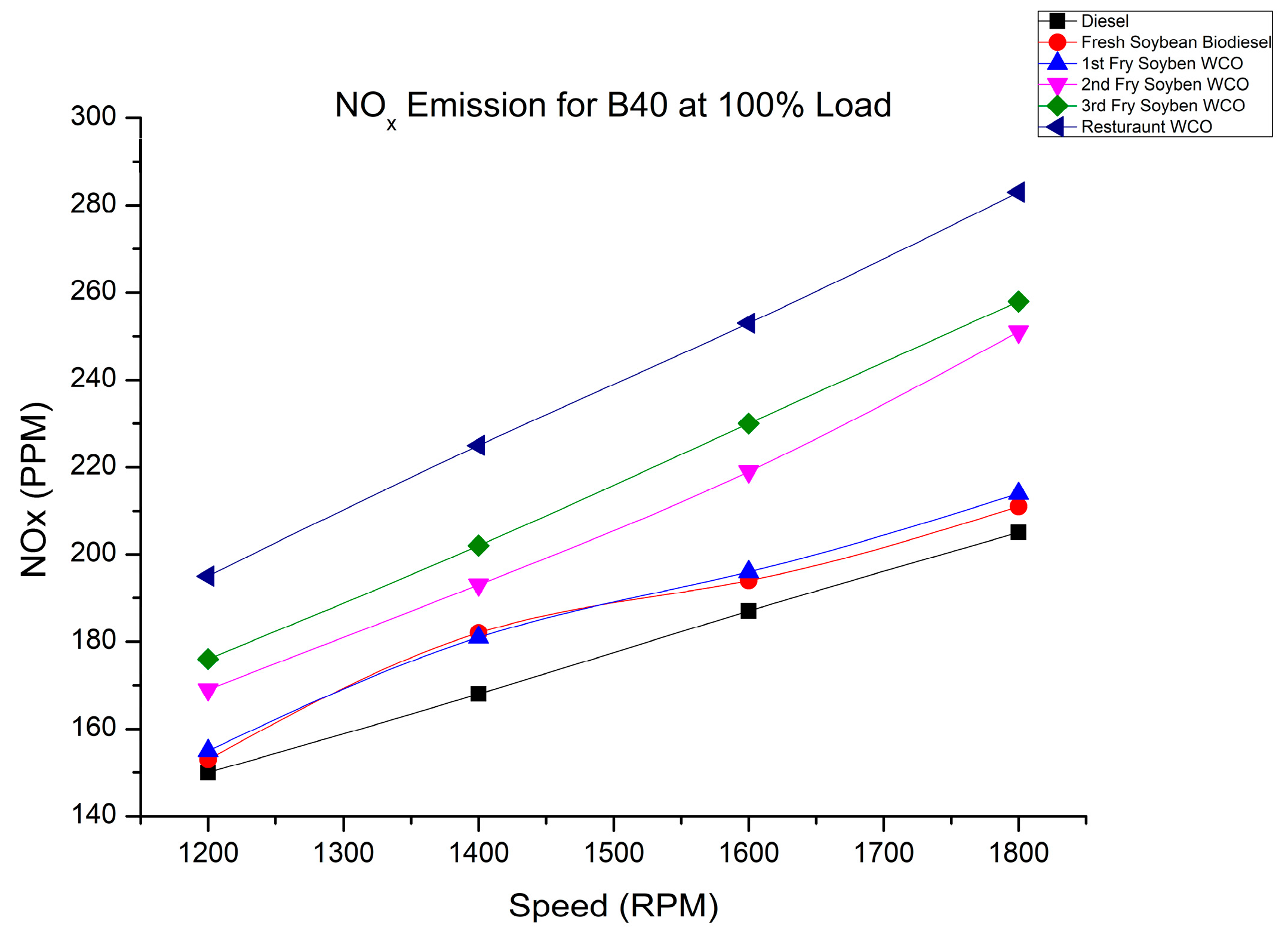
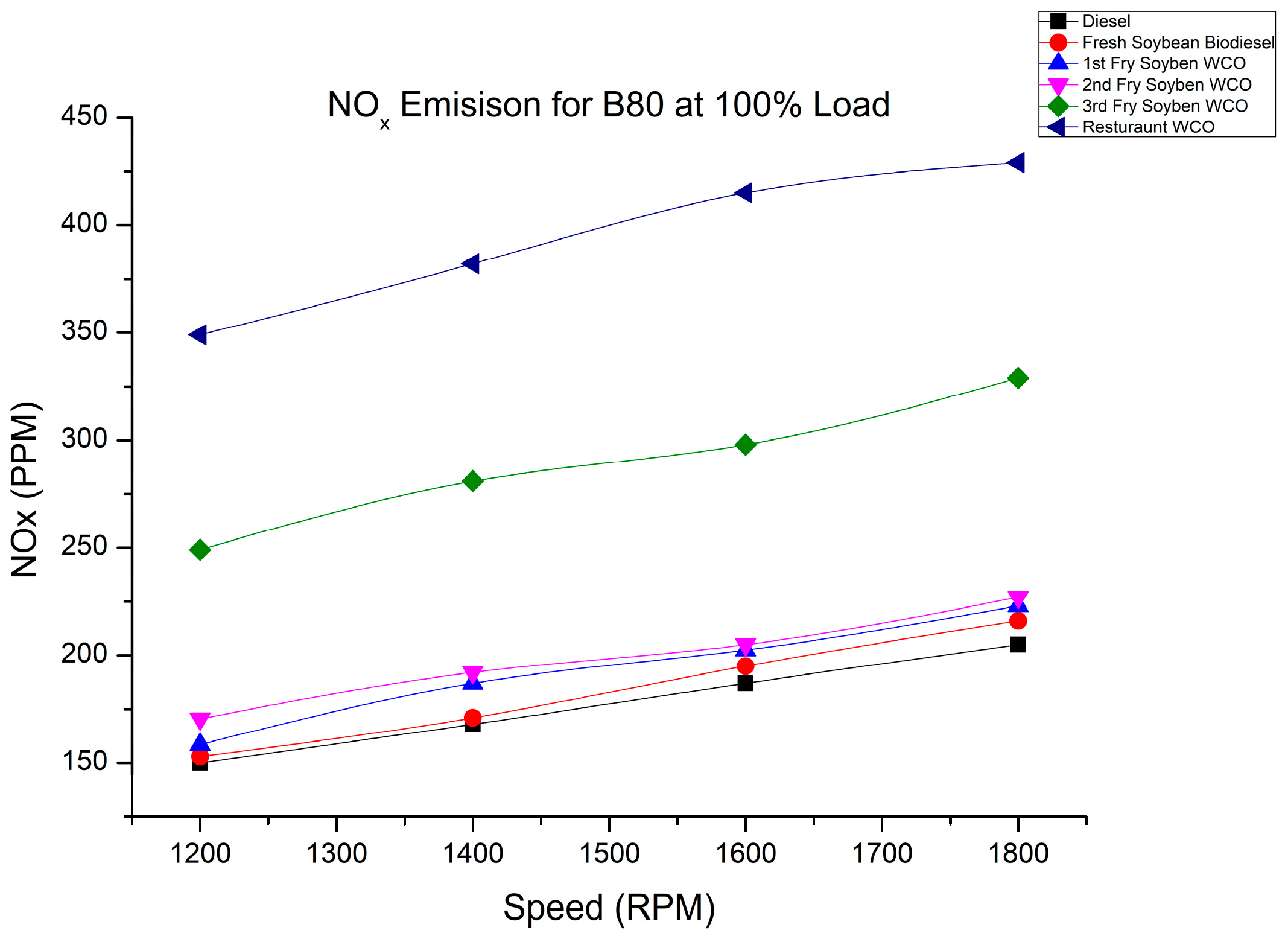
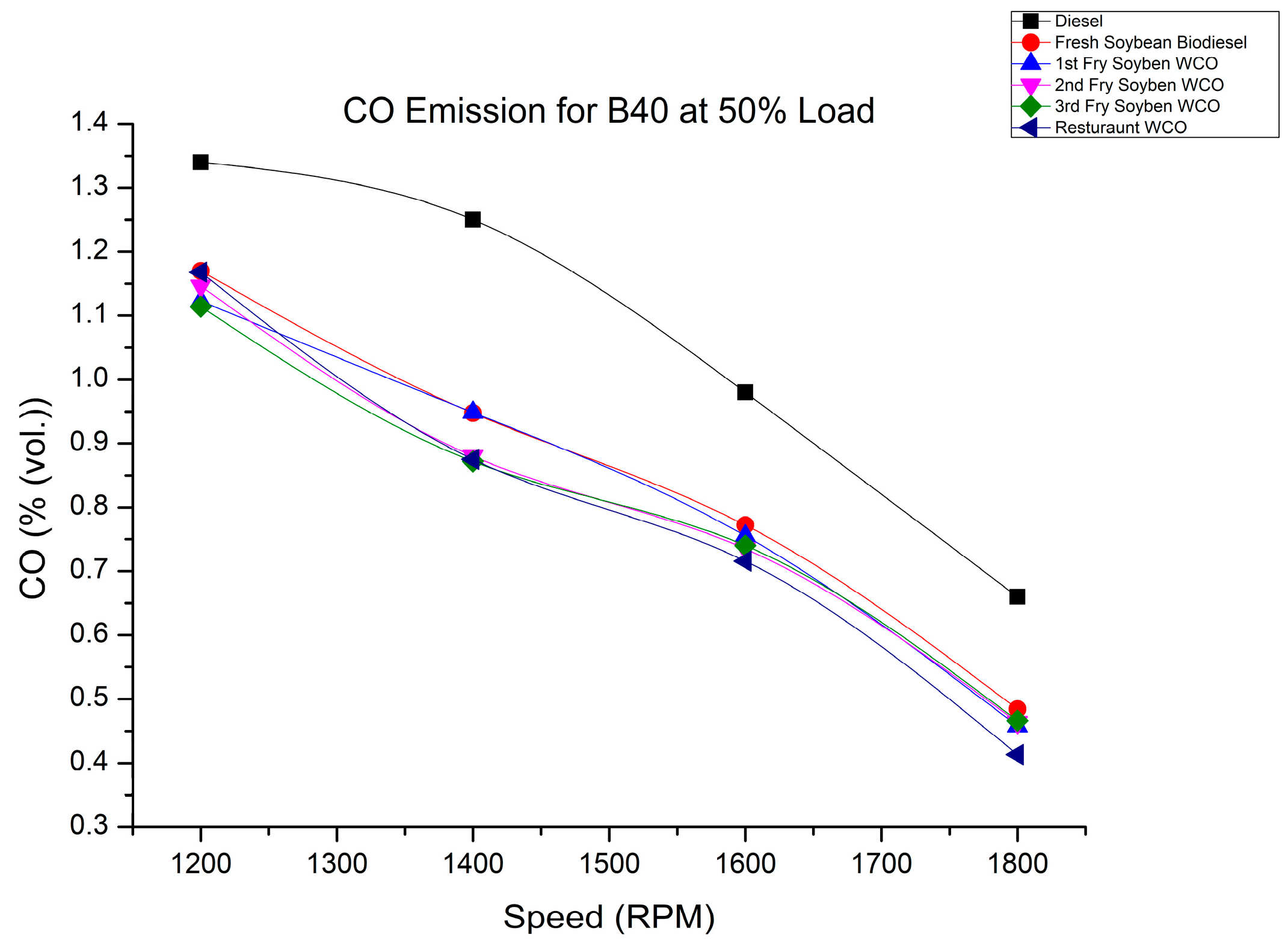
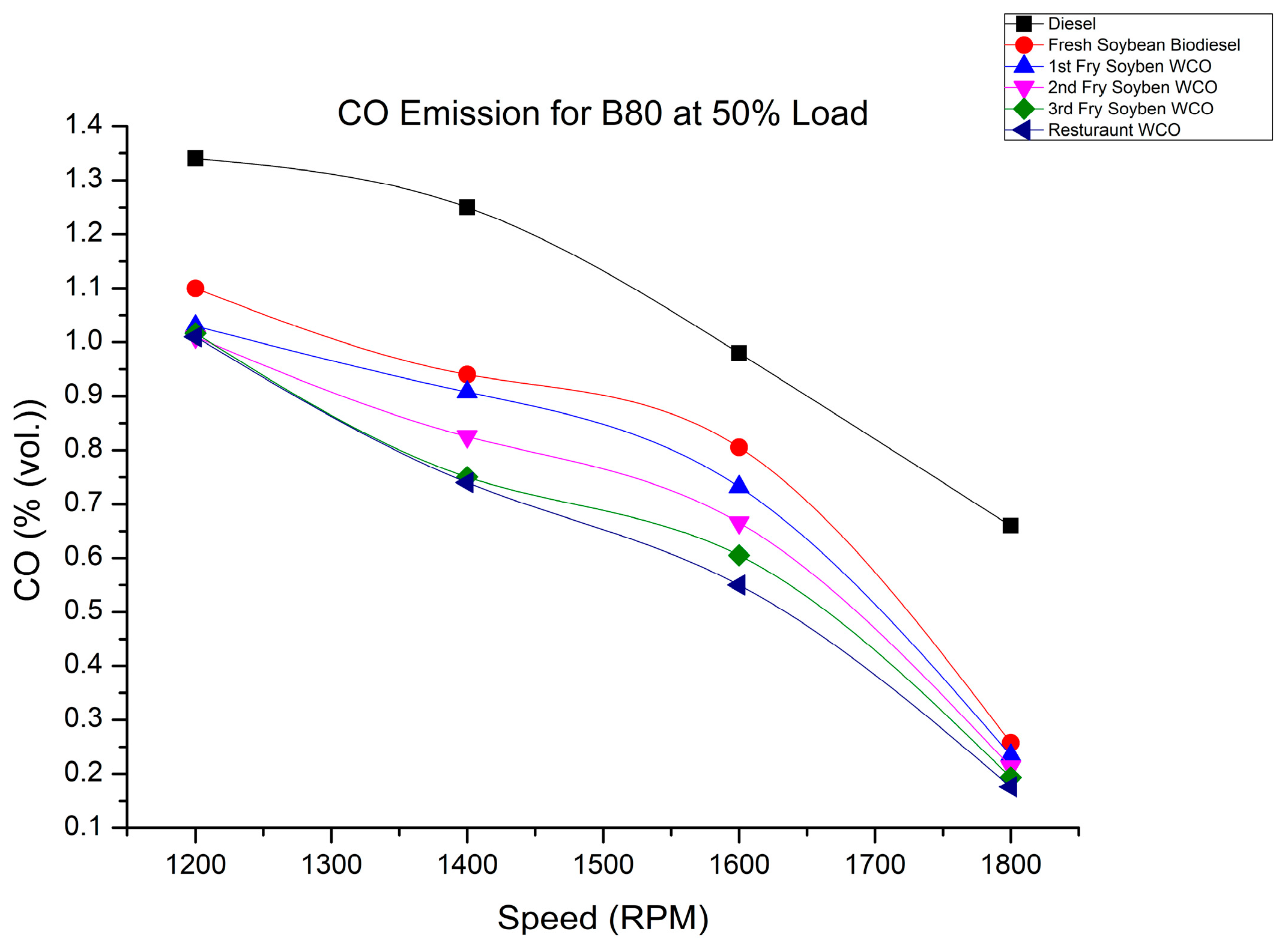
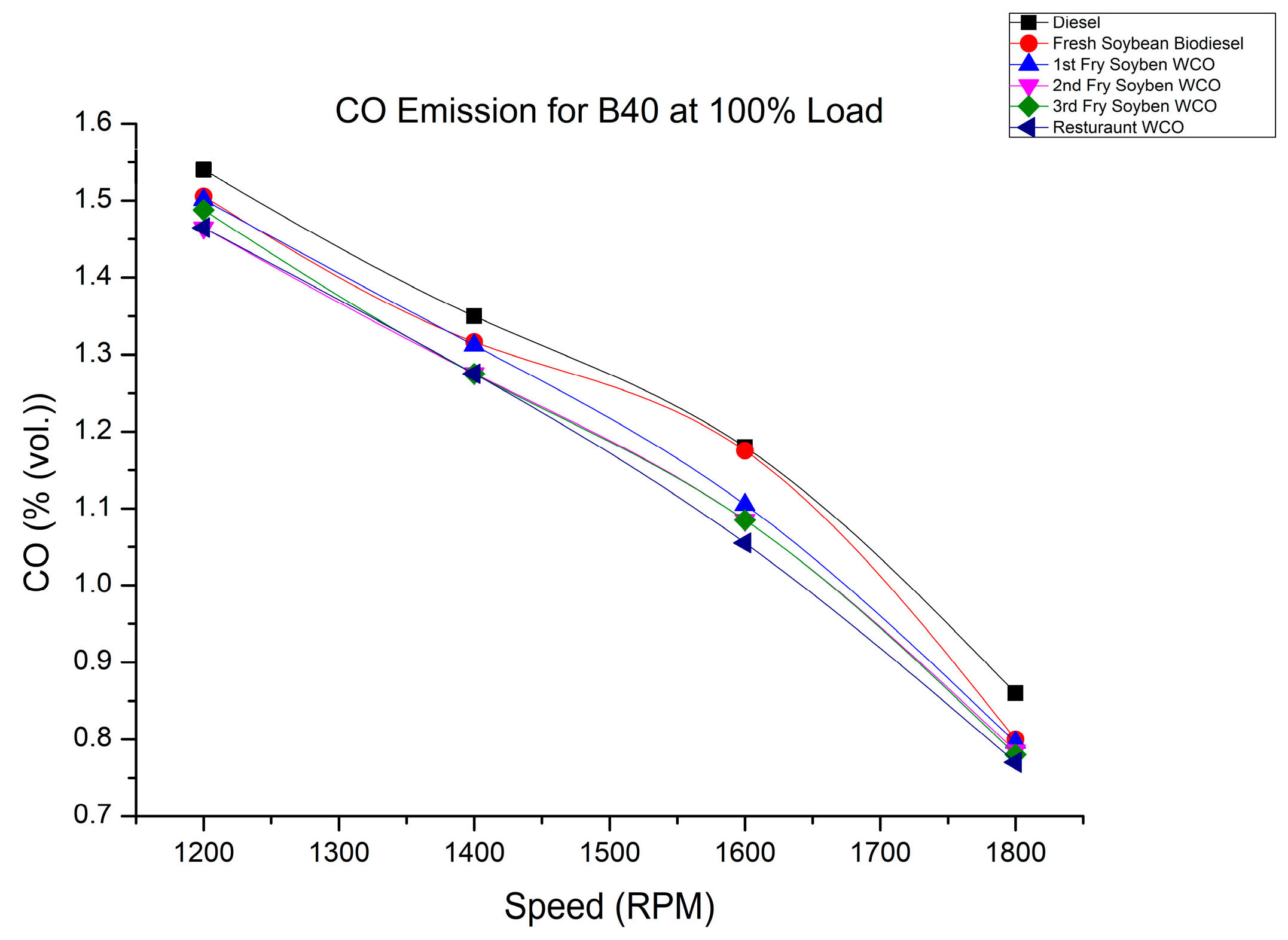
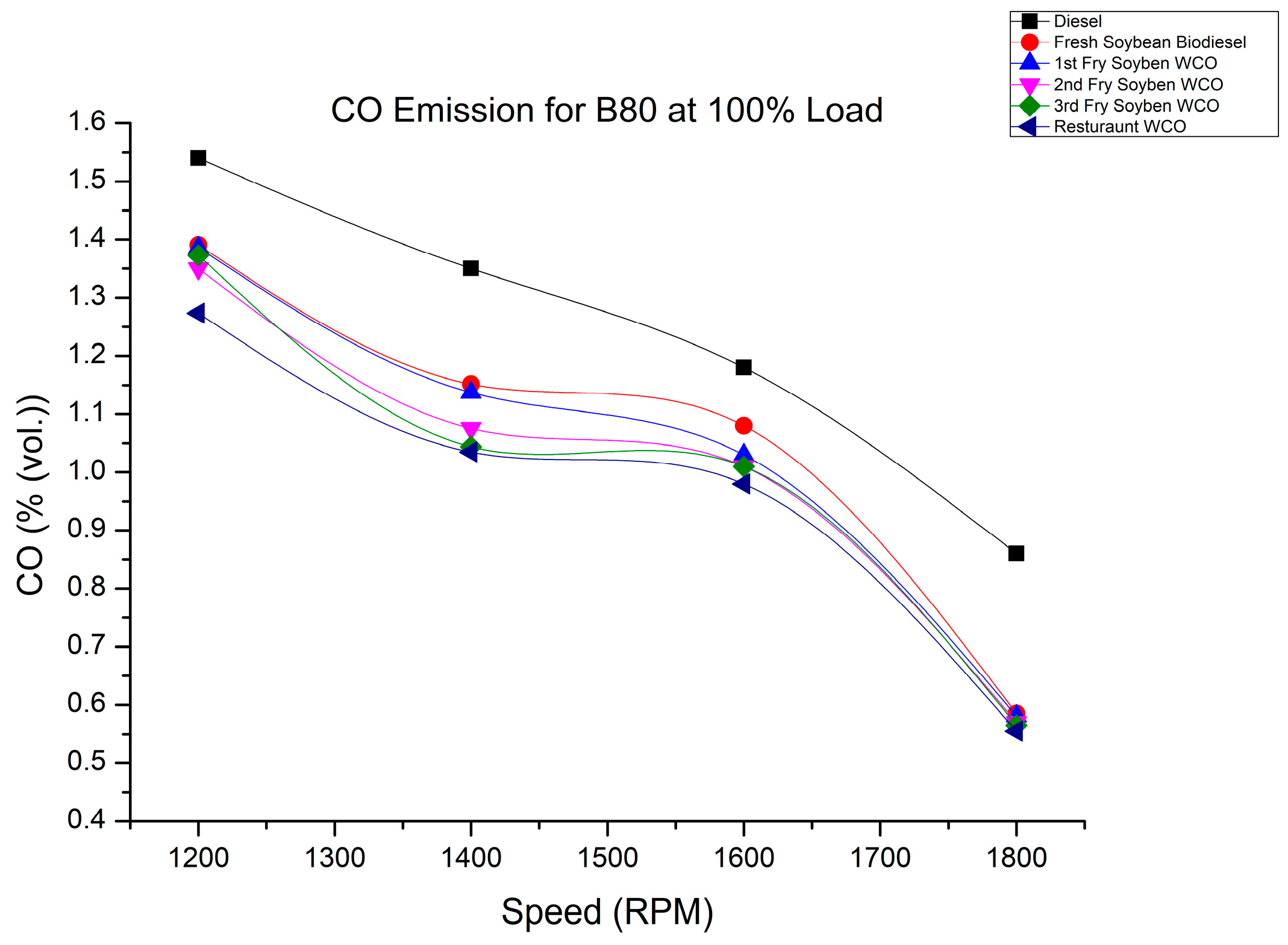

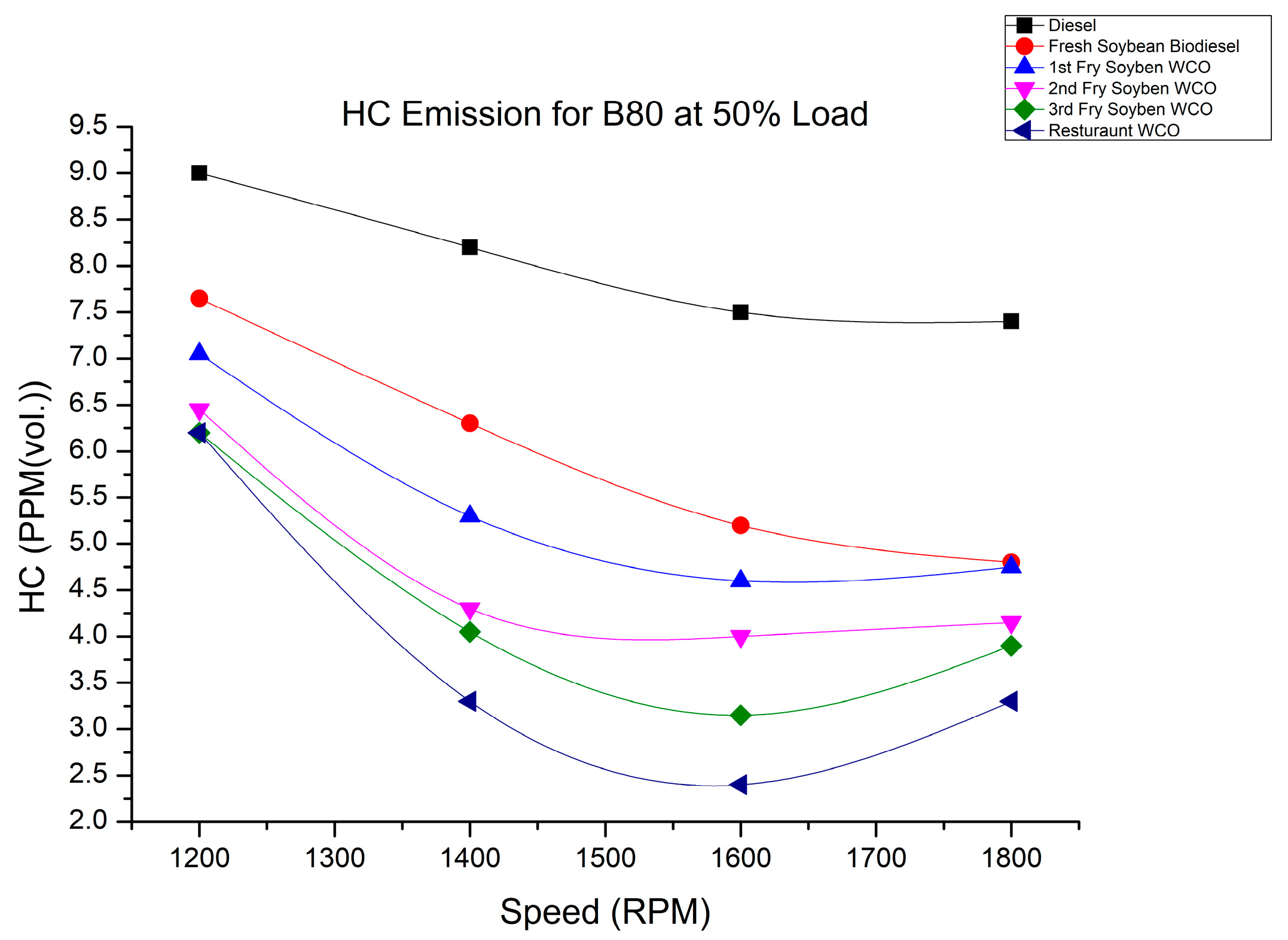
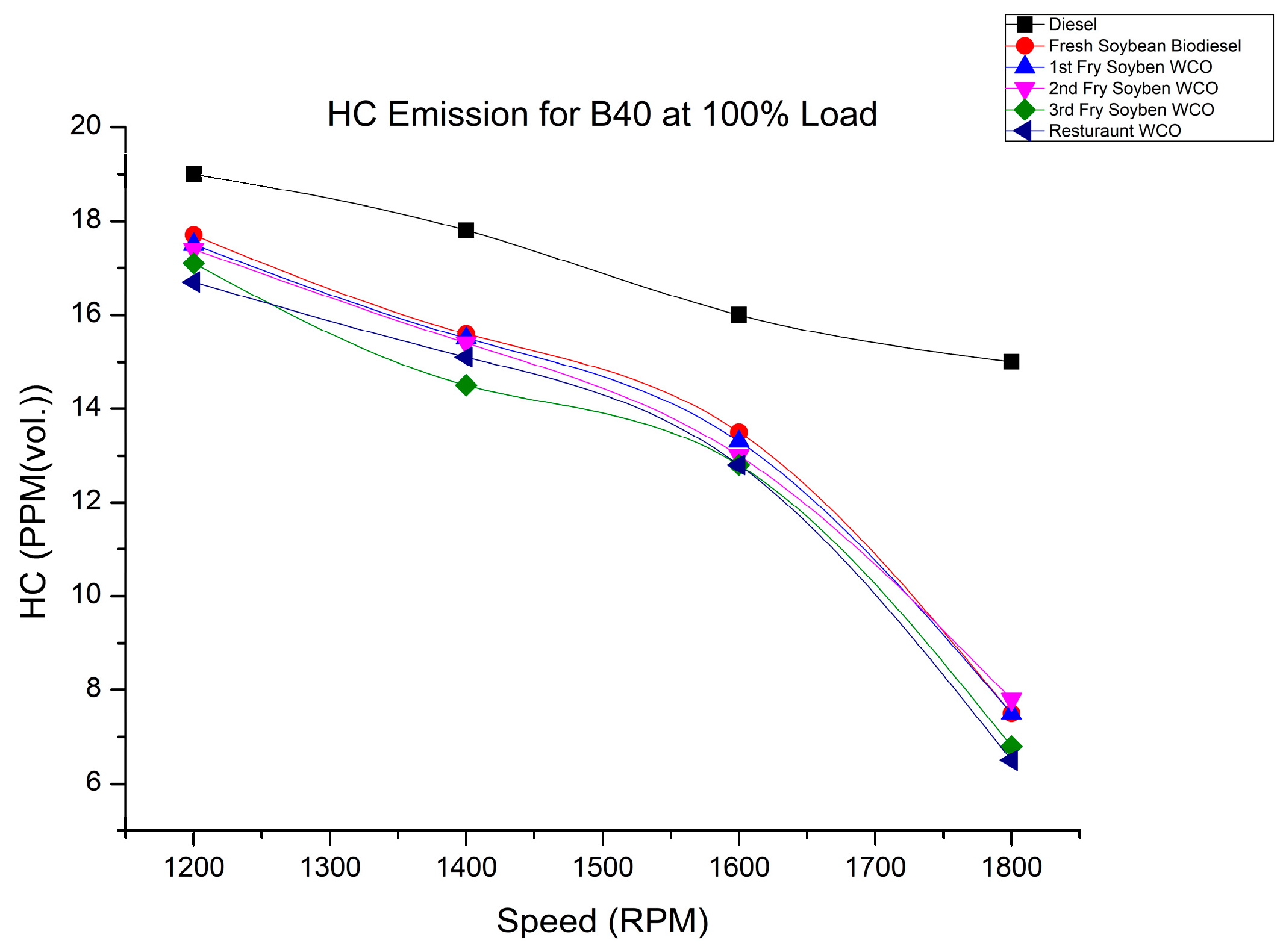
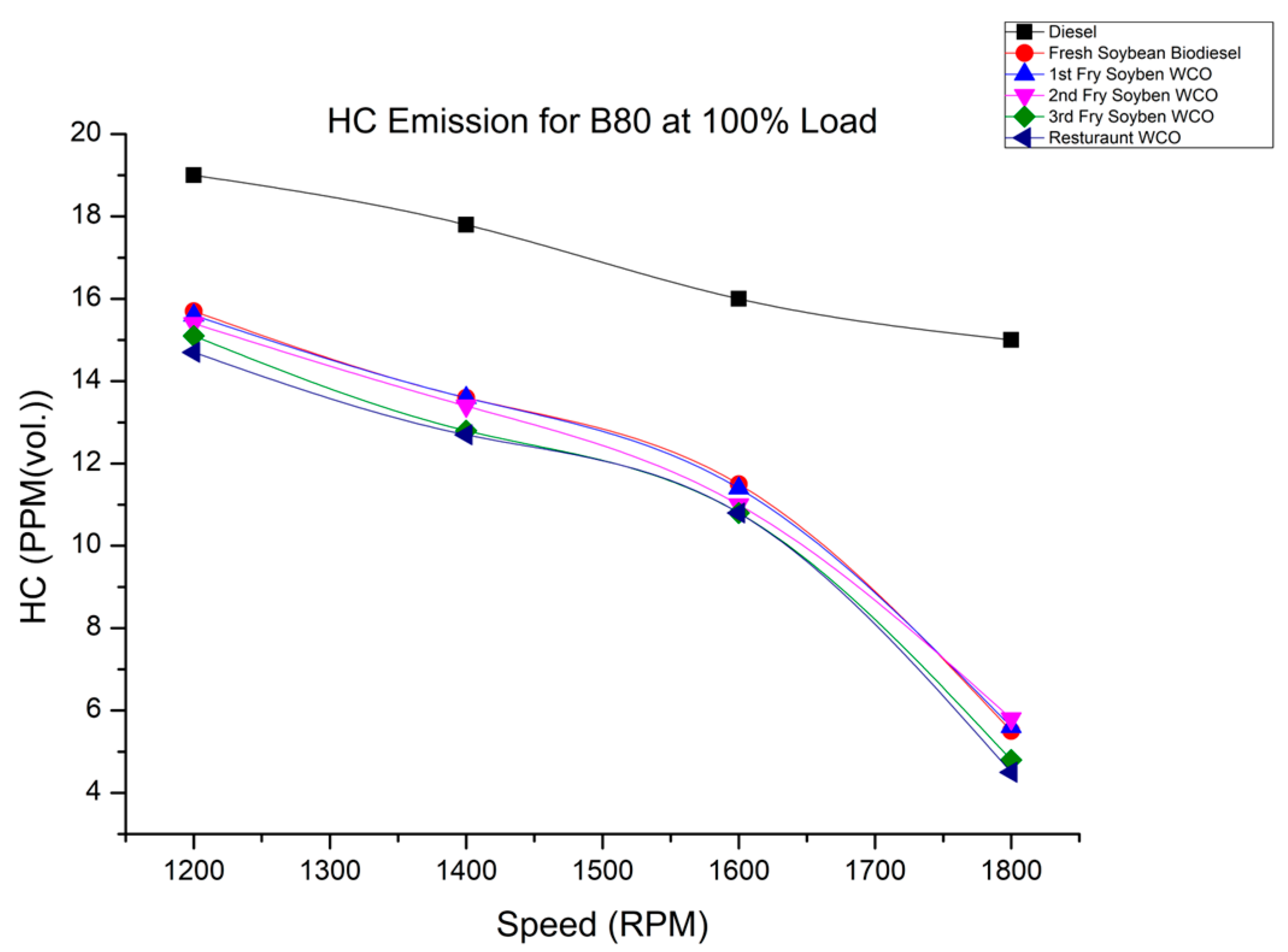
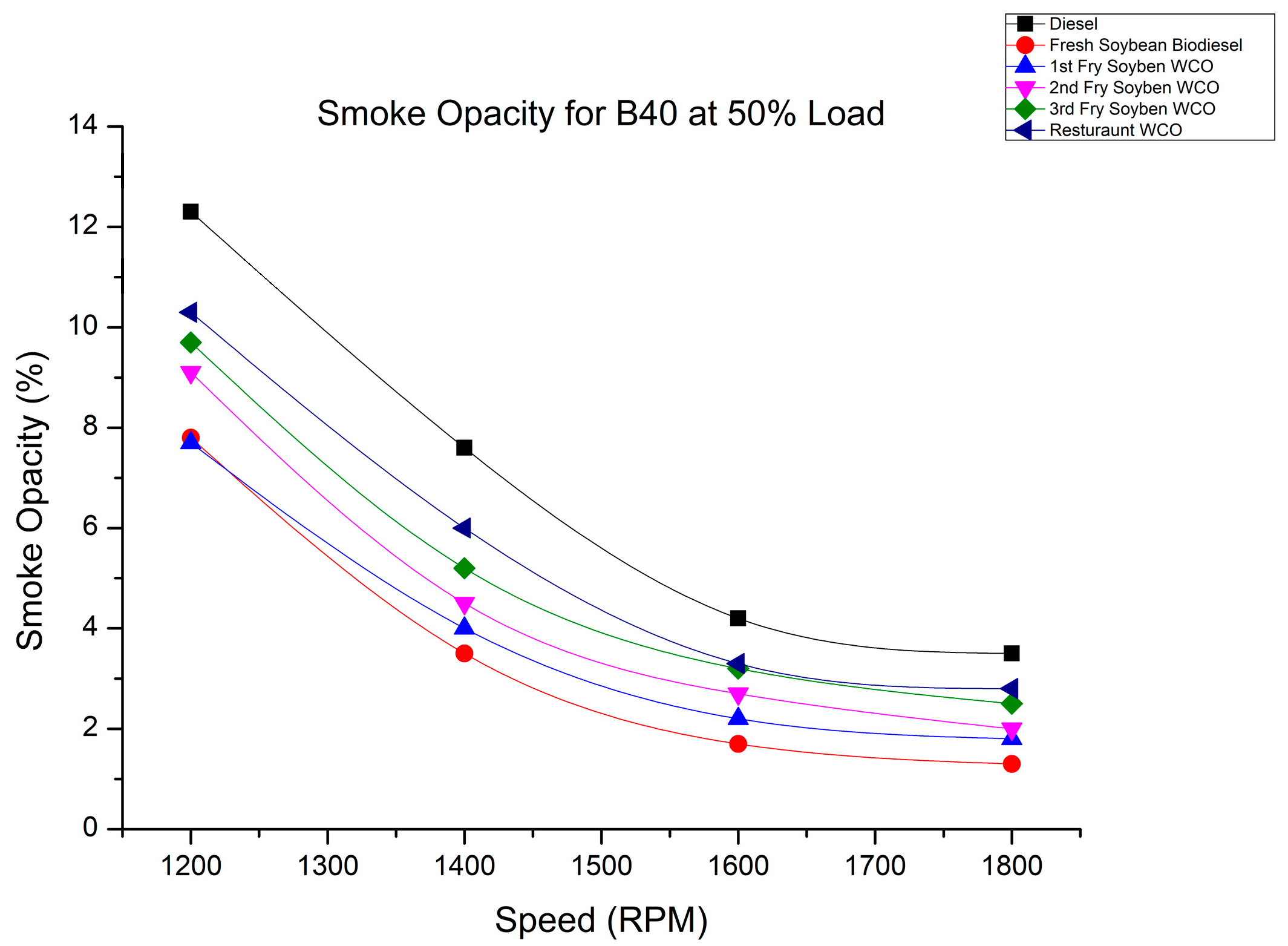
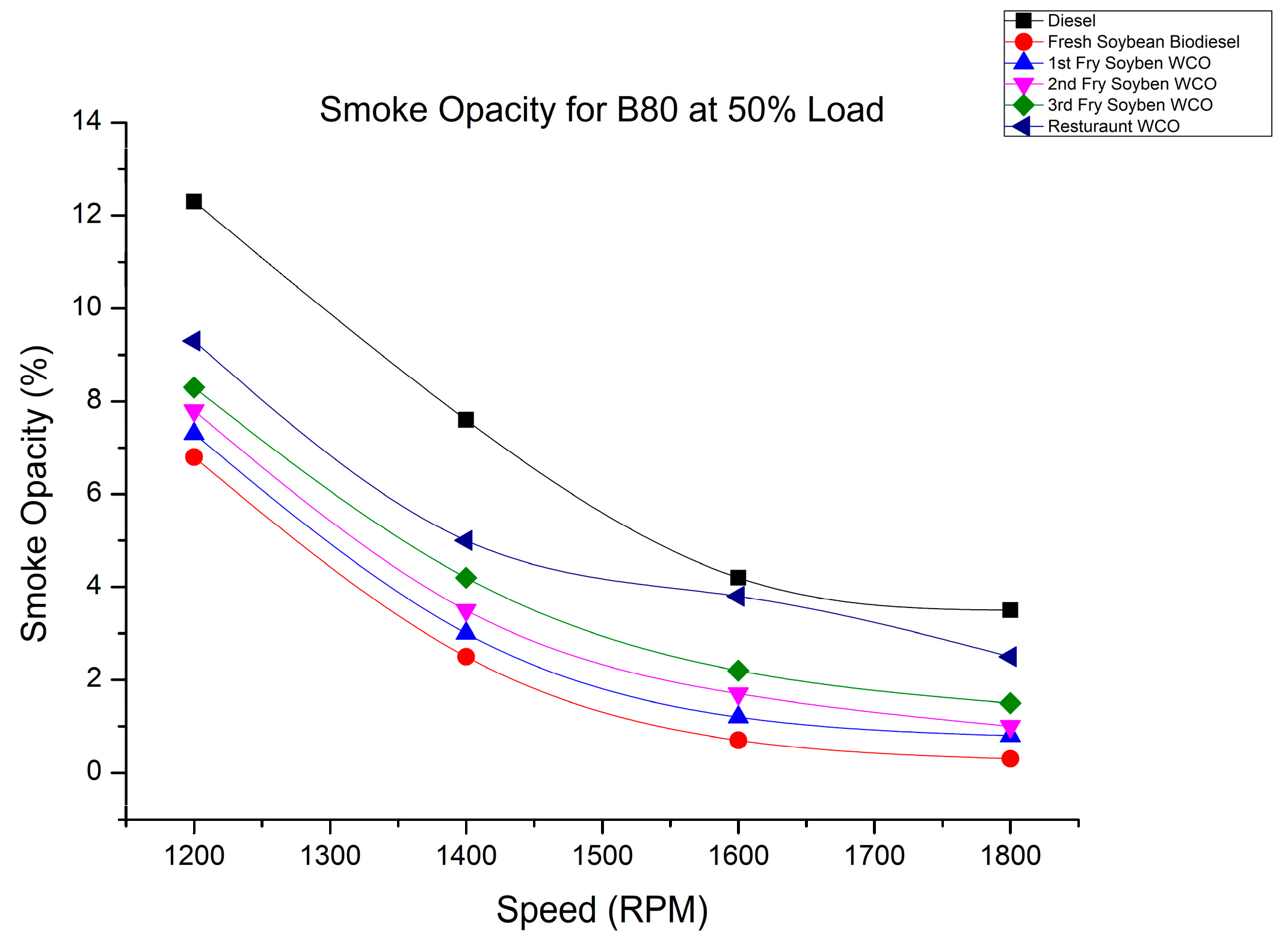

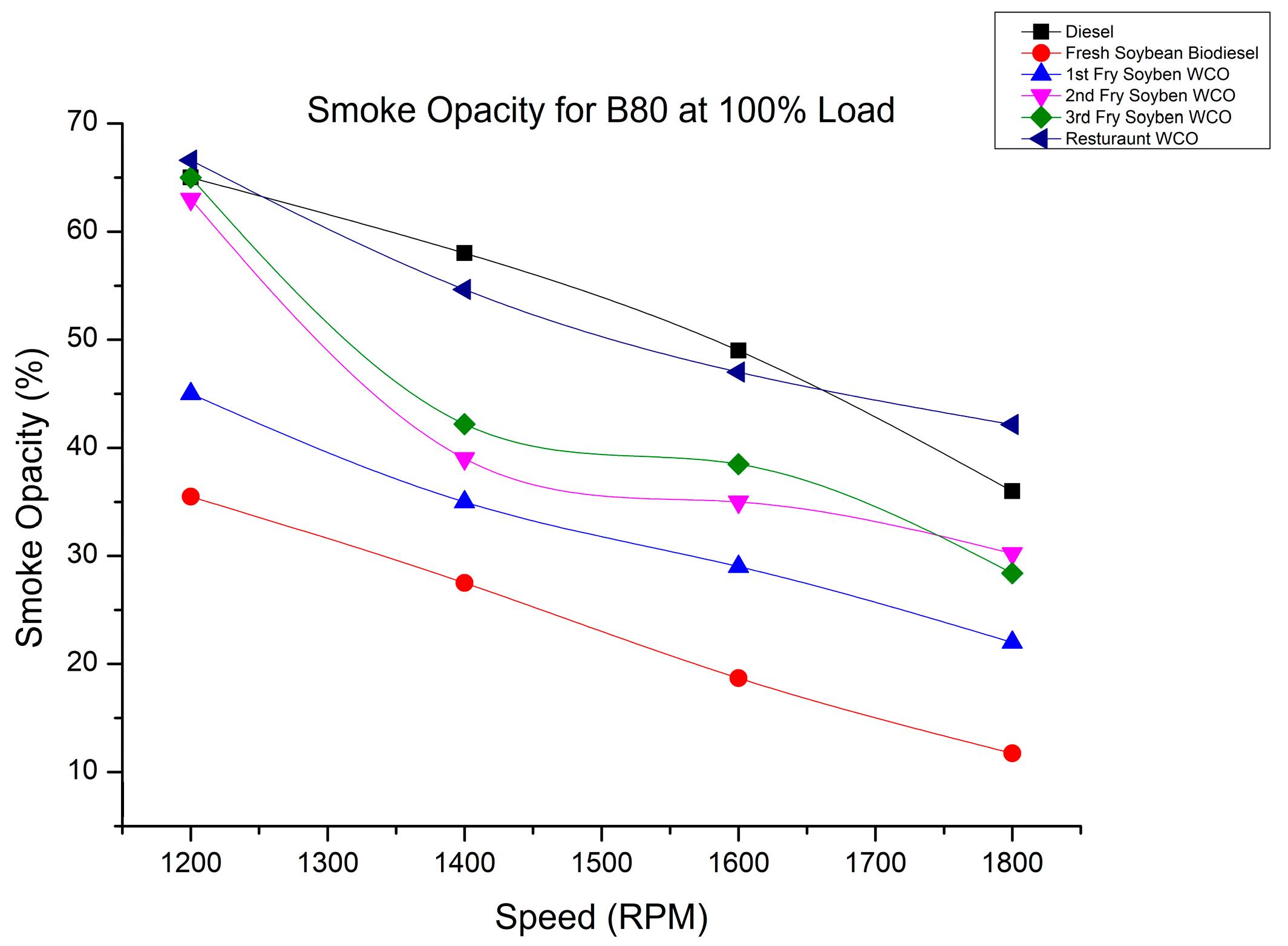
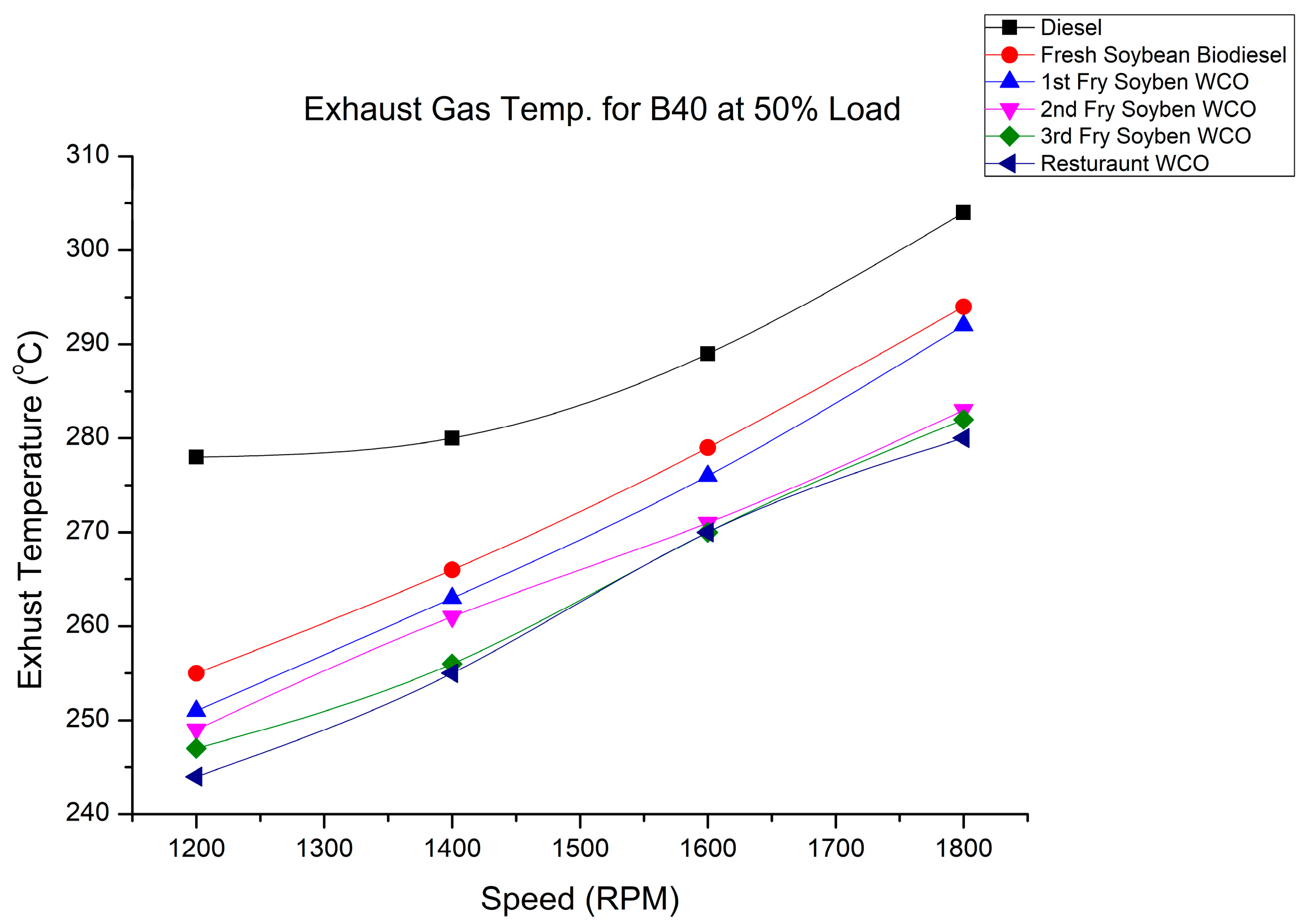
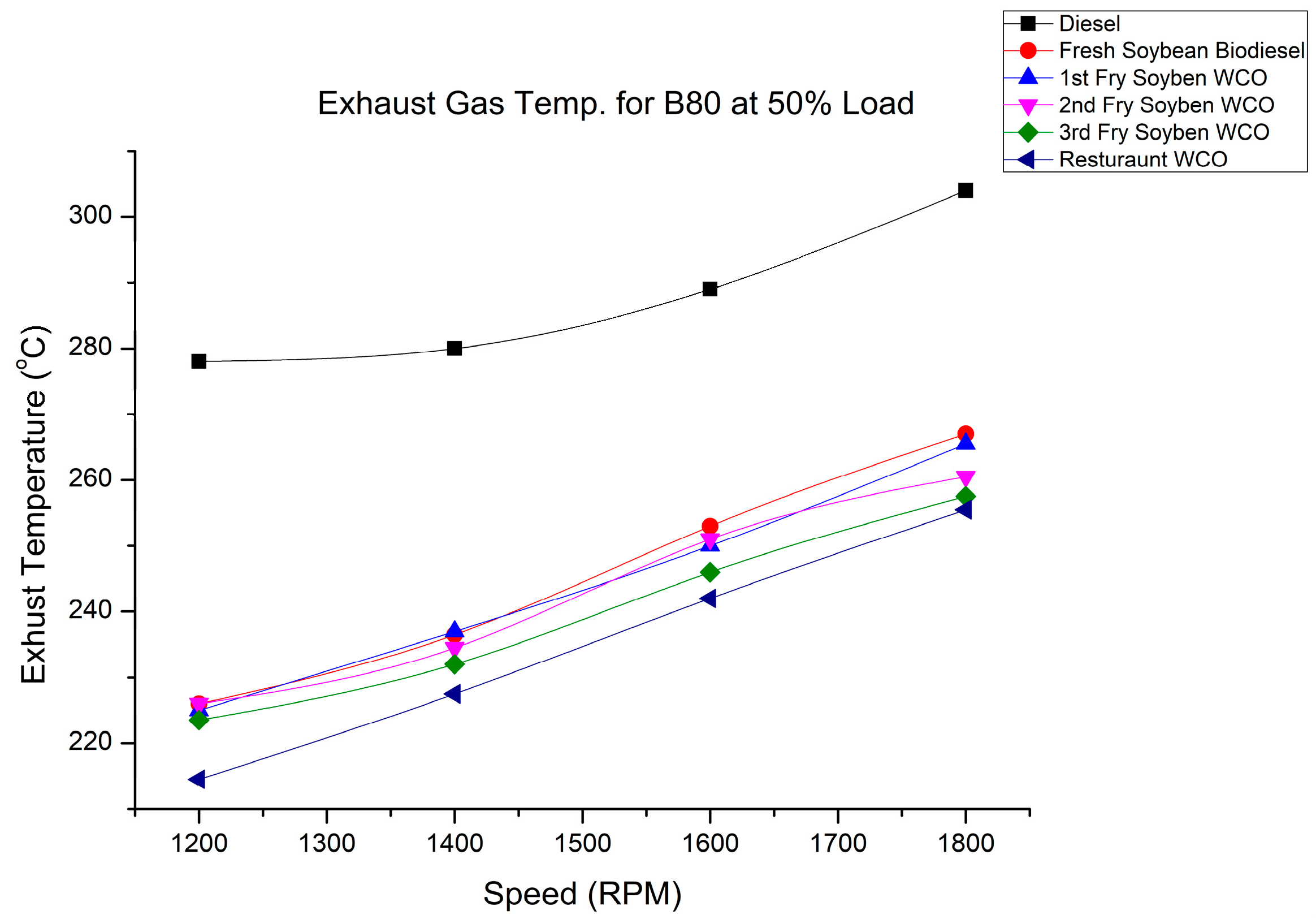
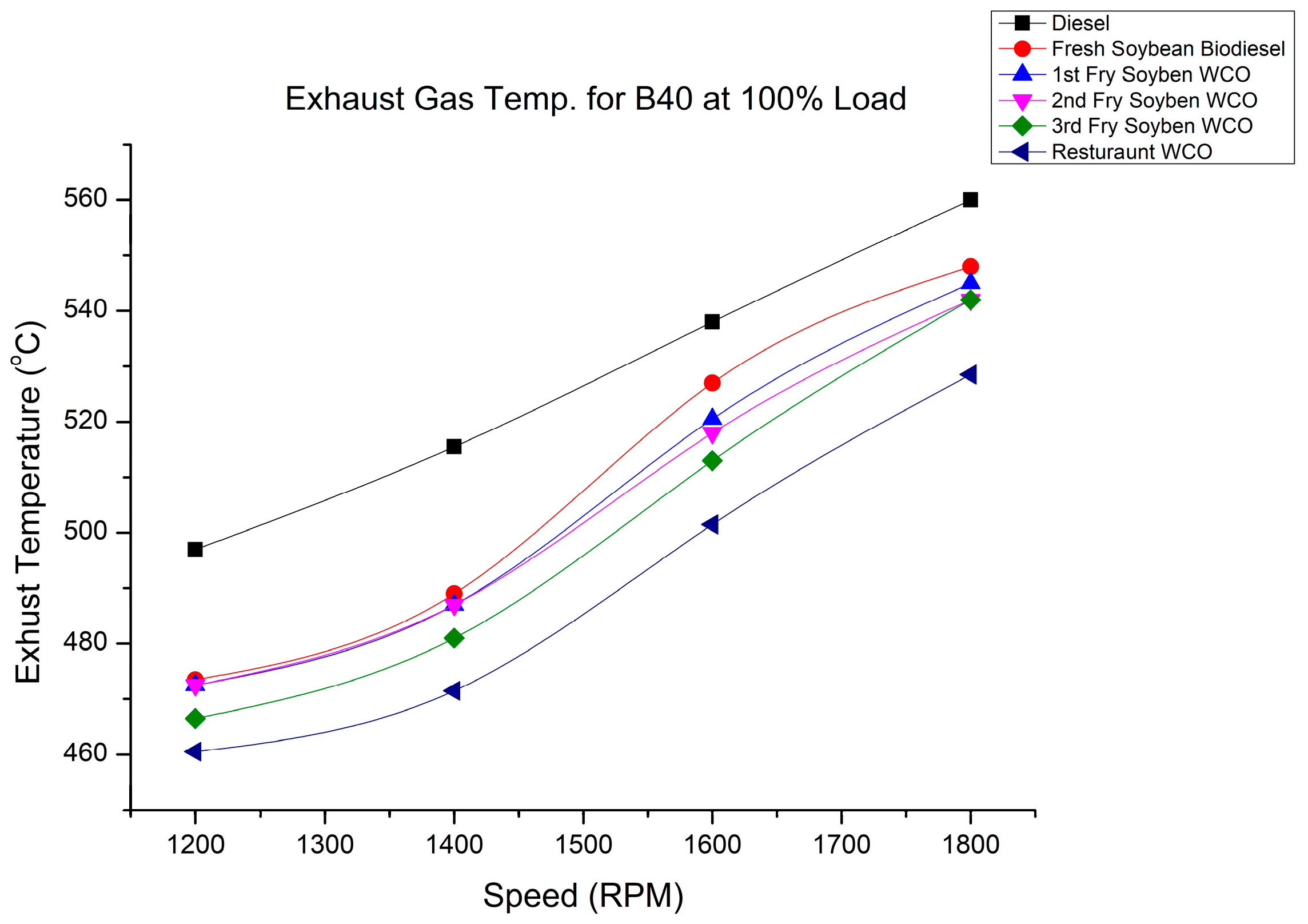
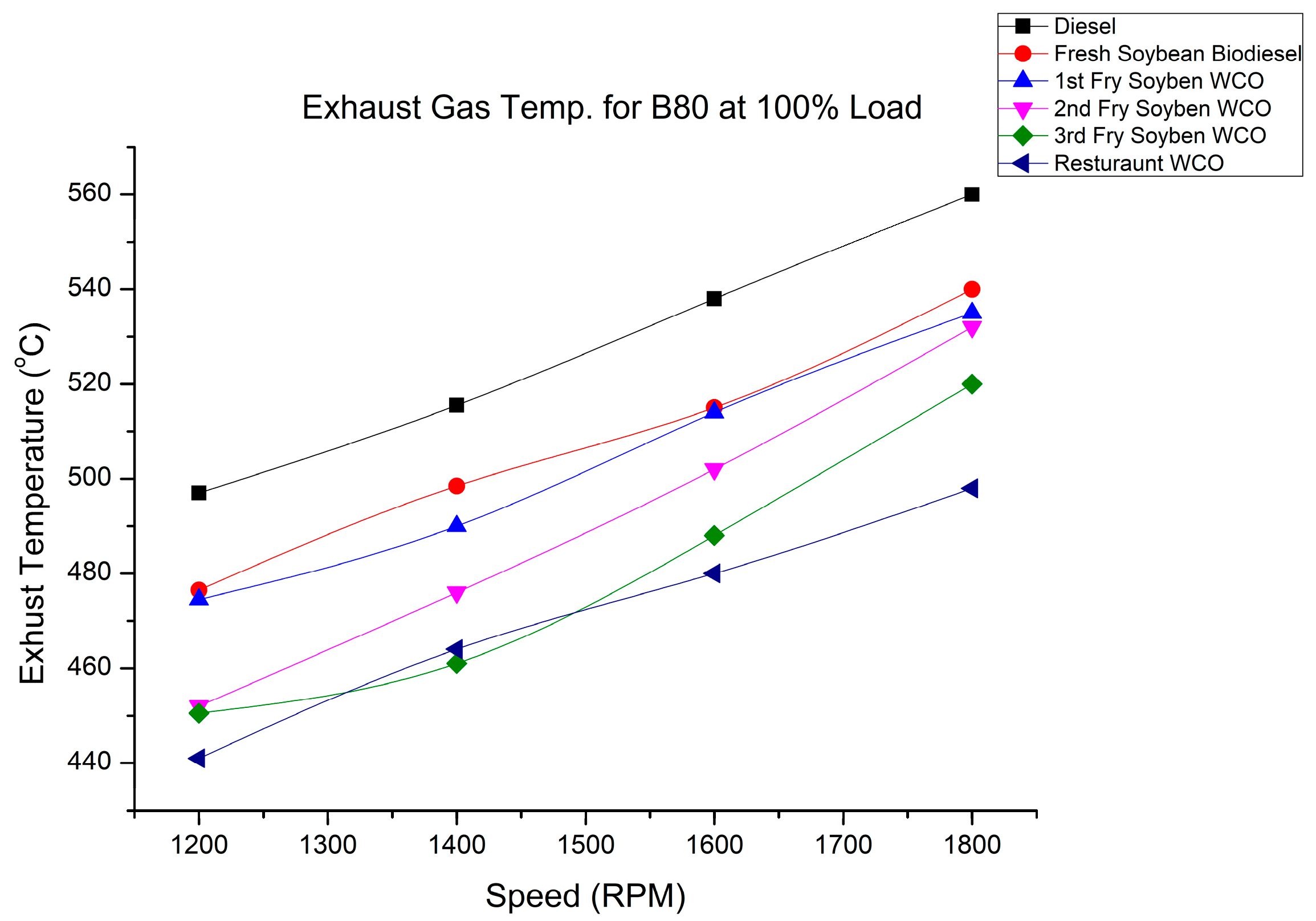
| S. No | Test | ASTM Test | ASTM Limits |
|---|---|---|---|
| 1 | Kinematic viscosity, mm2/s | D 445 | 1.9–4.1 |
| 2 | Cloud point, °C | D 2500 | - |
| 3 | Pour point, °C | D 97 | 4.4–5.5 °C |
| 4 | Flashpoint, °C | D 93 | 52 °C min |
| 5 | Sulfur by weight, % | D 129 | 0.5% max |
| 6 | Cetane number | D 613 | 40 min |
| 7 | Density | D 5002 | 15–35 °C |
| Property | Unit | Standard (ASTM) | Diesel | SOB | 1FWCOB | 2FWCOB | 3FWCOB | RFWCOB |
|---|---|---|---|---|---|---|---|---|
| Density | kg m3 | 900 | 833 | 837 | 841 | 858 | 871 | 886 |
| Viscosity | mm2/s | 1.9–6 | 2.72 | 3.95 | 4.41 | 4.66 | 4.79 | 4.91 |
| Calorific value | kJ kg−1 | >33,000 | 43,400 | 39,691 | 39,435 | 38,915 | 38,121 | 38,012 |
| Cloud point | °C | −2 to 12 | −8 | −6 | −6 | −6 | −5 | −4 |
| Flashpoint | °C | >130 | 78 | 67 | 73 | 77 | 84 | |
| Pour point | °C | −15 to 10 | −6 | −11 | −11 | −9 | −8 | |
| Cetane number | CN | 55.32 | 51 | 49 | 47 | 44 | 43 | |
| Sulfur content | % | 0.048 | 0.16 | 0.014 | 0.012 | 0.012 | 0.011 |
| Parameters | Unit | Description |
|---|---|---|
| Manufacturer | - | Daedong Korea |
| Engine stroke | - | 4-stroke |
| Engine layout | - | Horizontal |
| Displacement | cc | 673 |
| Cooling | - | Water-cooled |
| Number of cylinders | - | 1 |
| Compression ratio | - | 21 |
| Bore | mm | 95 |
| Stroke length | mm | 95 |
| Rated power output | kW | 7.4 |
| Injection pressure | kg cm−2 | 135 |
| Emission Gases | Resolution | Range |
|---|---|---|
| NOx | 1 ppm | 0–5000 ppm |
| CO | 0.001% | 0–9.999% |
| HC | 1 ppm | 0–10,000 ppm |
| Smoke | 0.05% | 0–100% |
Disclaimer/Publisher’s Note: The statements, opinions and data contained in all publications are solely those of the individual author(s) and contributor(s) and not of MDPI and/or the editor(s). MDPI and/or the editor(s) disclaim responsibility for any injury to people or property resulting from any ideas, methods, instructions or products referred to in the content. |
© 2023 by the authors. Licensee MDPI, Basel, Switzerland. This article is an open access article distributed under the terms and conditions of the Creative Commons Attribution (CC BY) license (https://creativecommons.org/licenses/by/4.0/).
Share and Cite
Mandal, A.; Cha, D.; Cho, H. Impact of Waste Fry Biofuel on Diesel Engine Performance and Emissions. Energies 2023, 16, 3711. https://doi.org/10.3390/en16093711
Mandal A, Cha D, Cho H. Impact of Waste Fry Biofuel on Diesel Engine Performance and Emissions. Energies. 2023; 16(9):3711. https://doi.org/10.3390/en16093711
Chicago/Turabian StyleMandal, Adhirath, Dowan Cha, and HaengMuk Cho. 2023. "Impact of Waste Fry Biofuel on Diesel Engine Performance and Emissions" Energies 16, no. 9: 3711. https://doi.org/10.3390/en16093711
APA StyleMandal, A., Cha, D., & Cho, H. (2023). Impact of Waste Fry Biofuel on Diesel Engine Performance and Emissions. Energies, 16(9), 3711. https://doi.org/10.3390/en16093711







